16. July 2018 |
Christoph Heilig |
Keine Kommentare
Again, we would like to share with you some new reviews of recent monographs by members of our group:
Jutta Leonhardt-Balzer in JSNT 39 (p. 103) on Monika Götte‘s Von den Wächtern zu Adam: Frühjüdische Mythen über die Ursprünge des Bösen und ihre frühchristliche Rezeption:
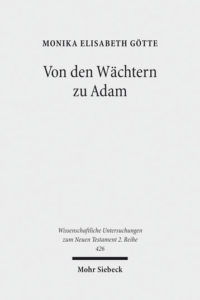
This revised Zurich PhD thesis studies the two most important models for the explanation of the origin of evil in early Judaism and early Christianity: the Watcher myth and the Adam motif. After an introduction on myths and different forms of the explanation of evil (strict monotheism, fall of the watchers, dualistic ideas, fall of Adam, primordial fall of Satan, and evil inclination), the first main part examines the watcher myth (1En. 1–36) and its reception, both in Jewish (1En. 85–90, Jubilees, Qumran, Testaments of the Twelve Patriarchs, Ben Sira, 3Maccabees, Philo, Liber Antiquitatum Biblicarum, Josephus, 2Baruch) and Christian sources (1 Corinthians, 1 Peter, Judas, Justin Martyr, Tatian, Athenagoras, Irenaeus, Clement of Alexandria, Bardesanes of Edessa, Tertullian, Origen, Cyprian, Commodianus, ps-Clementine Homilies). The second main part studies the Adam myth (Gen. 3), which replaced the watcher myth over time, looking again at Jewish (see above, plus 4Maccabees, 2Enoch, 4Ezra, Apocalypse of Adam, Apocalypse of Moses, Life of Adam and Eve) and Christian sources (much of the above, plus Romans, 1 Timothy, Revelation, Hippolytus of Rome, Lactantius).
The thesis provides an impressively comprehensive overview of the plurality of early Jewish and early Christian concepts of the origin of evil and draws attention to the shift in its explanation from the Watcher myth with its involvement of supernatural powers towards the Adam myth and its focus on human nature, both times in an attempt to explain the origin of evil without God’s involvement. The range of material ensures that this book will be a welcome resource for the study of these two myths for quite some time to come.
The author has summarised her work on our blog here.
Gudrun Nassauer in RBL 07/2018 on Christoph Heilig’s Paul’s Triumph: Reassessing 2 Corinthians 2:14 in Its Literary and Historical Context: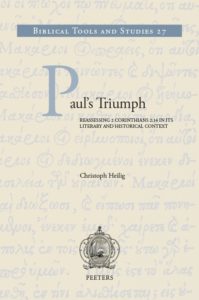
The title of this recent work by Christoph Heilig is already part of the question: Does 2 Cor 2:14 demonstrate that Paul imagines himself as triumphant, or does the metaphor rather point to the end of the triumphal procession and being led to execution, which a number of scholars associate with the possible Roman background of θριαμβεύειν? In any case, the metaphor Paul uses in 2 Cor 2:14b and its implications for the reconstruction of the Pauline self-understanding have puzzled Pauline research for a long time. In his monograph Heilig tries to resolve the questions linked to the interpretation of the verse by means of a comprehensive semantic analysis, by a discussion of different options for the metaphor’s cultural background, and in a critical dialogue with earlier interpreters. […]
The present volume is a very fine piece of exegetical work that provides us with fresh and helpful insights for considering an important problem related to the appropriate understanding of Paul’s apostolic self-understanding. Heilig supports his lexical semantic analysis and his exegesis of the triumph metaphor with extensive evidence drawn from both the study of Greco-Roman sources and the dialogue with earlier research on 2 Cor 2:14. His methodology seems very well thought out and is inspiring. The same is true of his consistently careful linguistic analyses and exegetical interpretations. In sum, this stimulating read can be highly recommended.
Learn more about the book here!
Abgelegt unter: From us or people associated with us⋅ Reviews of our work
15. June 2018 |
Christoph Heilig |
1 Kommentar
Check out these brand-new, very positive reviews of two books by members of our group in leading German-speaking journals:
Prof. Andreas Lindemann in the „Theologische Rundschau“ (82/3) on Jordash Kiffiak’s Responses in the Miracle Stories of the Gospels: Between Artistry and Inherited Tradition:

„Das letzte hier vorzustellende Buch, 2017 erschienen, ist die an der Hebräischen Universität in Jerusalem geschriebene Dissertation von Jordash Kiffiak. … Thema sind die in den Wundererzählungen überlieferten, sehr unterschiedlichen Reaktionen der Menschen auf das geschehene Wunder, traditionell als ‚Chorschluss‘ bezeichnet. K. betont, dass es zu diesem Aspekt der Wundererzählungen in den Evangelien bislang noch keine monographische Studie gegeben hat. … Der sehr umfangreiche Band ist sorgfältig und nachvollziehbar gegliedert. … Man wird bei einem derart umfangreichen, m. E. im besten Sinne als ‚innovativ‘ zu bezeichnenden Werk Fragen und Einwände vorbringen können. Gleichwohl scheint mir die Studie von Jordash Kiffiak im Ansatz und in der sorgfältigen Durchführung der Frage nach der Bedeutung der ‚responses‘ in den Wundererzählungen in ganz besonderer Weise erwähnenswert zu sein.“
(Learn more about the book here and here!)
Prof. Dietrich-Alex Koch in the „Theologische Literaturzeitung“ (143/68) on Christoph Heilig’s Paul’s Triumph: Reassessing 2 Corinthians 2:14 in Its Literary and Historical Context:

„Christoph Heilig legt eine umfassende sprachliche und exegetische Untersuchung zu der [in 2. Kor 2,14] verwendeten Metapher vom Triumphzug vor. Nach einleitenden Ausführungen zu Aufgabenstellung und Vorgehensweise (Chapter 1, 3–24) folgt das grundlegende 2. Kapitel (25–116), in dem der Vf. erstmalig mit Hilfe des TLG eine vollständige Auflistung aller verfügbaren Vorkommen des Verbs θριαμβεύειν bietet (37–51), die er anschließend hinsichtlich der lexikalischen Verwendung analysiert. Damit liefert er für alle künftigen Diskussionen eine stabile Grundlage. … Im 7. Kapitel (241–259) führt der Vf. die bisher gewonnenen Er¬gebnisse zusammen. Er hebt zwei zentrale Elemente der Metapher vom Triumphzug hervor: Das Herumgeführtwerden und das Mo¬ment der Beschämung der Herumgeführten in den Augen der Zuschauer. … Der Vf. hat die Diskussion um die Bedeutung von θριαμβεύειν in 2Kor 2,14 auf eine neue Grundlage gestellt und diese Analyse wagemutig mit einer zugespitzten These verknüpft. Auch wenn man dieser These nicht zu folgen vermag, wird diese Arbeit die künftige Diskussion maßgeblich bestimmen.”
Learn more about the book here!
Abgelegt unter: From us or people associated with us⋅ People
3. May 2018 |
Jordash Kiffiak |
1 Kommentar
In a two-day intensive workshop last summer, Dr. Michael P. Theophilos of the Australian Catholic University offered members of the New Testament Peer Mentoring Group of the University of Zurich a highly informative, hands-on look at the important contributions that numismatic evidence can make for understanding the meaning of Greek words used in the documents contained in the New Testament and related literature.

Participants in this intimate setting were handsomely rewarded with an elaborate 79-page (!) handout, replete with numerous images of ancient artefacts, especially coins and their inscriptions.
An additional treat were the numerous specimens of a variety of monetary instruments, especially ancient Roman provincial coins, Theophilos brought from his personal collection for illustrative purposes.
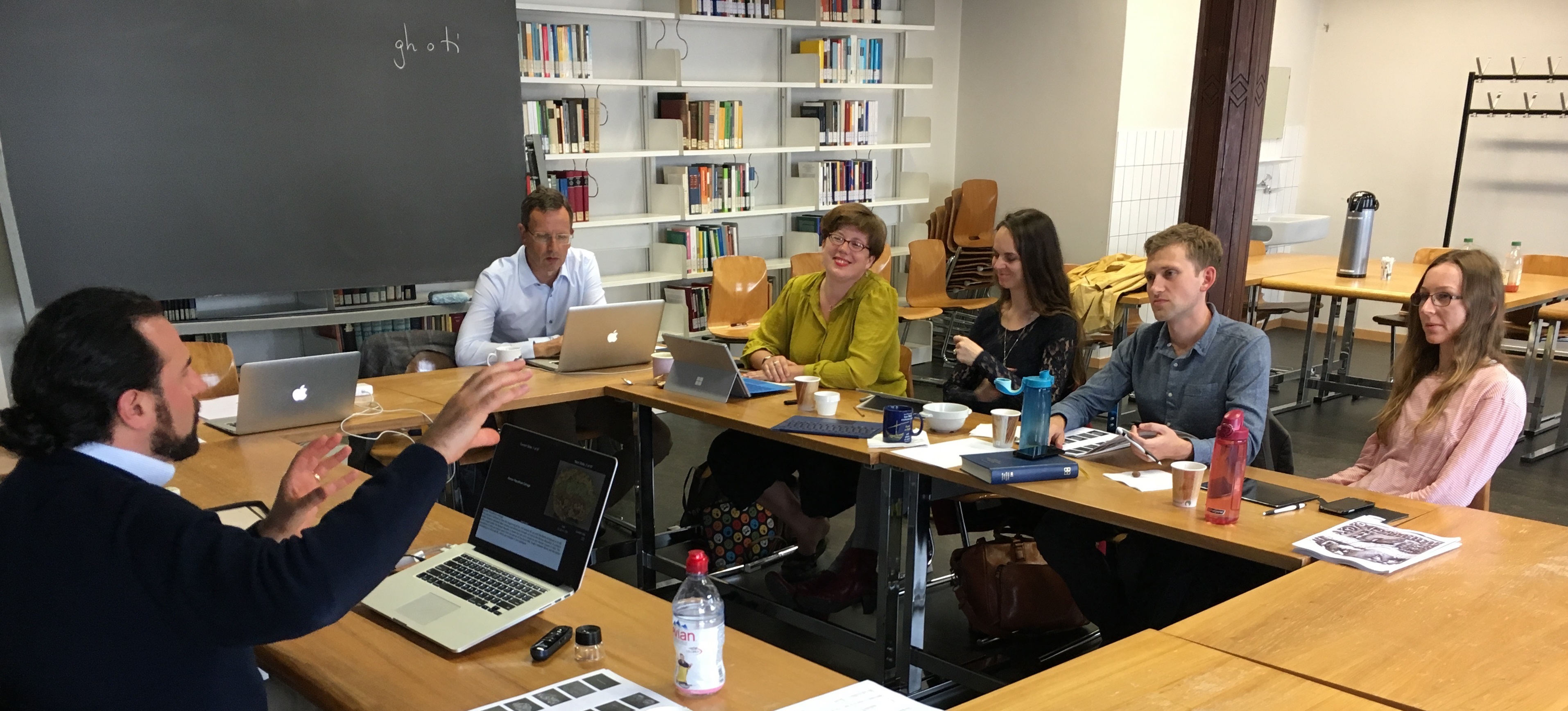
We met from morning to evening on 26–27 July, 2017, as Theophilos provided the group with the year’s keynote event. The first day was in essence a lengthy introduction. In the second day we dove into case studies. A chair of the biblical lexicography section at the Society of Biblical Literature, Theophilos has noted for years the lack of engagement with numismatic evidence among lexicographers. His workshop drew on material he has been preparing for publication to help remedy the situation. His forthcoming monograph with T&T Clark, Numismatics and Greek Lexicography, is dedicated precisely to this issue.
Day 1 – Introduction
A History of Coins
Before leading us on our journey of discovery to the usefulness of Greek inscriptions on coins, Theophilos provided us with a history of coins. First, however, he offered a brief tour of human engagement with monetary instruments, employing both social-anthropological and historical vantage points. From shells (China, as early as the 13th century BCE), through kissi pennies, that is long metallic wire (Sierra Leon and Liberia, 19th and 20th centuries), and rings of woven feathers (Solomon Islands, 20th century) to the coins, bills and plastic cards that the world is now most familiar with, we surveyed the varied means by which humans seek to secure resources and the power they offer, as well as to facilitate the economic exchange of goods and services. Theophilos often surprised the workshop’s participants with real examples of the phenomena depicted in his presentation slides.
Next our guide narrated the history of coinage, specifically. Beginning with the early gold and silver coins of the Lydians, bearing no inscription, with a simple picture of an animal on the obverse (front) and just a punch on the reverse (back), he brought us to the more sophisticated coins of the Archaic and Hellenistic periods, for which it became customary to have inscriptions, especially, in time, the name of the ruler, along with a portrait of his face.
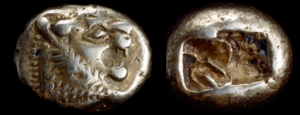
Portraying the Hellenistic rulers as, above all, associated with the gods and even comparable to them (Alexander as Heracles, Lysimachus as Zeus Ammon etc.), served to re-inforce the image of their power and legitimacy. The basic lesson learned is that coinage so often served not just as a means to facilitate commerce but also – and more – to further the agendas of power structures of antiquity.

Theophilos took us down to the Roman systems of coinage, first in the Republic and then in the early Empire, both of which are modelled on and heavily influenced by their Greek predecessors. Coinage of the Roman Empire, the primary focus for our period of study, is split into imperial and provincial types. Imperial coinage, both in image and inscription, is notably fixated on the personality of the emperor in a more direct way. The texts are characterized by ever-growing title attributions to the emperors, punctuated by a complex system of abbreviations.
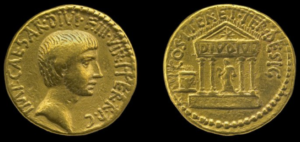
Provincial coinage, containing Greek inscriptions, allowed for more variety of representations and content. These coins, constituting the focus of our workshop on lexicography, address relations, at times involving fascinating political factors, between the emperor and the people of specific regions.
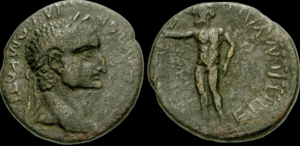
For New Testament scholars, a notable point of interest would be, of course, the land of Israel. Indeed, during Theophilos’ historical survey, he devoted a detailed excursus on coins of all types – Persian, Hellenistic, Roman and Jewish revolt coins – that pertain to that region. Involving inscriptions in Paleo-Hebrew, Greek and Latin, various interest groups express their relation to and perspective on the land in which Jesus’ followers and their ancestral people lived and ruled or were ruled over. I might pause here to mention how impressed we were with Theophilos’ breathtaking breadth of knowledge of numismatics. And beyond all of this he is a New Testament scholar and expert in Greek lexicography.
Striking Coins
Along the way, Theophilos described and then illustrated how coins are struck inside a coin die. A large obol-shaped base contains on its top the obverse image of the coins-to-be, formed in the opposite direction of how the struck coins will appear. A lighter lid, containing the reverse’s image (again with the direction flipped), fits on top of the base. A blank (an unstruck coin) is heated and placed on top of the base; the lid is affixed on top; and then the die is literarily struck with a hammer. Eleven surviving die found at the Roman mint in Lugdunum (Lyon, France) contain a curious specimen. One die actually has a denarius still lodged in it, offering a wonderful picture of coin striking in action, as it were.
The way coins were made meant that they could be re-struck. This action, in itself, could have political implications. A notable example is the making of revolt coins of the First Jewish Revolt, employed the Tyrian shekel. Prior to the revolt, the Tyrian shekel, though it boasted both a bust of the god Melkart and the inscription ΤΥΡΟΥ ΙΕΡΑΣ ΚΑΙ ΑΣΥΛΟΥ (“of Tyre, the holy and inviolable”), was the exclusive coin accepted by the temple authorities in the late Second Temple period.
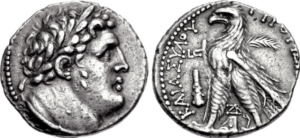
These shekels were reminted by the revolters to contain objects sacred to Jewish practices and to say, in paleo-Hebrew script, ירושלים הקדושה (“Jerusalem, the holy”).
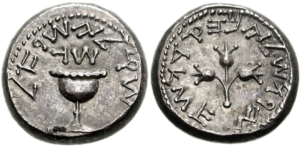
Then, in the Bar Kokhba revolt, the Tyrian shekel was once again recast as a coin with Hebrew inscription, now also with an image of the temple in Jerusalem. (Note the coin pictured below is another recast coin from this revolt.)
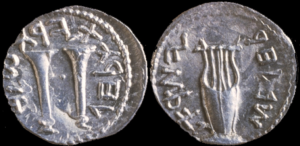
Authentication and Counterfeits
Another preliminary topic, perhaps especially important for non-specialists, is the problem of authentication and, conversely, counterfeits. Counterfeit coins are made in four ways: tooling or “cleaning” an existing coin into something else; using a cast with a clay mould; making a mould with electroplating (electrotyping) and striking an actual die. The last of these produces the worst fakes, because they can more easily trick specialists. Authenticating coins involves tests to prove that none of the four abovementioned processes have occurred. For example, patina will be missing in the grooves, when an authentic ancient coin has been tooled so that the hair stands out in more relief. (If such a counterfeit fools a buyer, the coin would be sold for more than its original worth, prior to tooling, on account of its appearance seeming to be preserved in more pristine condition.)
There are ten kinds of patina, some being more common than others. The different kinds are identified by their widely varying colors, which include “chocolate,” “forest green,” “blue” and “red”; Patina not only looks nice, it helps preserve the coin over the centuries. Another practical help is its effect of highlighting or emphasizing the parts of the coin that are in relief. Watch out though, you have to learn to distinguish between patina and bronze disease – the latter, if it gets into your collection, can destroy all your precious coins!

Day 2 – Cases Studies for Greek Lexicography
ΚΤΙΣΤΗΣ
One example that Theophilos examined with us in some detail is the word κτίστης. While the related noun (κτῖσμα) and verb (κτῖσαι / κτίζειν) appear frequently enough (4 and 15 instances, respectively) in the New Testament, our word is a hapax legomenon. It is understood by both BDAG and Louw-Nida in 1 Peter 4.19 as referring categorically to a cosmological creator, conceived of as a distinctly Jewish, also Christian, category. However, when the evidence from Roman provincial coinage is consulted, the interpretive possibilities are immediately broadened. Coins frequently use κτίστης to refer to the founder of a city. Both gods and contemporary human rulers are relevant. On a coin commemorating Tiberius’ restoration of Magnesia, following the earthquake of 17 CE that shattered 12 cities in the province of Asia, Tiberius is recognized as the founder. The obverse of RPC 1 2451 reads ΤΙΒΕΡΙΟΝ ΣΕΒΑΣΤΟΝ ΚΤΙΣΤΗΝ (“Tiberius Augustus founder”). The reverse has an image of the emperor restoring the goddess Tyche, as a symbolic act. Another example is RPC 1 2495, illustrated below from Theophilos’ personal collection, which has on its obverse ΣΕΒΑΣΤΟΣ ΚΤΙΣΤΗΣ (“augustus founder”) and on its reverse ΚΛΑΖΟΜΕΝΙΩΝ (“of Klazomenai”).
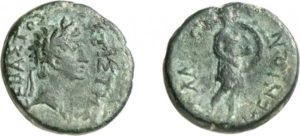
RPC 1 2495
The numismatic evidence shows clearly that describing an emperor as the founder of a city, on the one hand, constitutes a claim to trustworthiness, prestige and, importantly, power. The emperor has the power to establish and, thereafter, rule centers of human civilization. On the other hand, it bestows upon the city in question, along with its citizens, an elevated status, marked as worthy of receiving imperial attention. Out of comparative interest, Theophilos showed how also some coins from the land of Israel contain our word with the sense in question. Archelaus and Philipp the tetrarch are each called κτίστης. Thus, in 1 Peter 4.19 the author, using terminology widely known to reflect Roman imperial ideology, employs it to reassert the Jewish God’s ultimate control over the world powers. For the rest of the fascinating details I direct the reader to Theophilos’ essay, “Κτίστης (1 Peter 4:19) in Light of the Numismatic Record,” pages 191-205 in Biblical Greek in Context: Essays in Honour of John A. L. Lee (ed. T. Evans and J. Aitken; Leuven: Peeters, 2015).

ΦΙΛΟΙ
Theophilos’ handout addressed three other main case studies, each generously illustrated with pictures of the coins in question. Our guide brought numismatic evidence to bear on the question of Jesus’ “friends” in John 15.14. The disciples are declared his “friends,” if they do what he tells them. This idea draws on court loyalty, traceable back to the time of Alexander, expressed with gusto in the Roman imperial period, as is vividly illustrated on provincial coinage. In the abstract of Theophilos’ article on the topic, published after the workshop, he writes, “The inclusion of specific political terminology on Roman coins (for example, ΦΙΛΙΑ; ΦΙΛΟΚΑΙΣΑΡ; ΦΙΛΟΚΛΑΥΔΙΟΣ; ΦΙΛΟΡΩΜΑΙΟΣ; ΦΙΛΟΣΕΒΑΣΤΩΝ) was one way in which elite concepts of political friendship, evidenced in Cicero and Seneca, were communicated to the masses.” Roman emperors bestow the honour of “friendship” as a means of legitimation of certain puppet kings and other governing functionaries who follow the party line. In this context “friendship” is an honor that is active; it must be maintained. Coins show one powerful way of how this honor of friendship with the Caesar could be publicly displayed for a broad audience. The plausibility of the reading that Theophilos promotes in the instance in question in John is reinforced by comparison with the accusation levelled later against Pilate that he is not a “friend” of Caesar, because he seems to be favoring another would-be king (19.12). Theophilos’ study here shows how attention must be paid to the immediate context in which a common word appears in our literature, especially if in a lexicon the headword (the main entry) has multiple definitions. (For further details see Theophilos, “John 15.14 and the ΦΙΛ- Lexeme in Light of Numismatic Evidence: Friendship or Obedience?,” New Testament Studies 64 [2018]: 33-43.)
ΝΕΩΚΟΡΟΣ
Theophilos gave us another look at material he was preparing for publication, which has been published since the workshop. The use of νεωκόρος in Acts 19:35 does not constitute an anachronism read back from the second century into the first, Theophilos contends. Rather, properly understood, its use in our text can well be situated within the middle of the first century, as part of the development of the city of Ephesus’s devotion to Artemis, a trajectory that is documented in the numismatic evidence. (See Theophilos, “Ephesus and the Numismatic Background to ‘νεωκόρος,'” pages 299-332 in The First Urban Churches 3: Ephesus [ed. James R. Harrison, L. L. Welborn; WGRWSup 9; Atlanta, Ga.: SBL, 2018].)
ΧΑΡΑΚΤΗΡ
Finally, Theophilos shows that χαρακτήρ, “rather than necessarily being understood as ‘exact imprint,’ ‘representation,’ ‘impression,’ etc., can refer to the authenticating mark of a ruler, official or superior” (“The Numismatic Background of ΧΑΡΑΚΤΗΡ in Hebrew 1:3,” Australian Biblical Review 64 [2016]: 69-80, 69).
Although I would have preferred to offer here in this blog a fuller picture of this day’s look at numismatics and Greek lexicography, constituting the workshop’s central concern, I respect the presenter’s wishes to have me direct readers to the printed versions of his lexicographical studies. Unfortunately, the vast majority of the images of the coins and inscriptions for these studies are under copyright and so they also could not be reproduced here.
Related Topics and Learning Activities
The two-day workshop involved discussion of further topics and learning activities for the participants in areas related to ancient numismatics. The topics covered included the visual portrayal of various locations and objects and socio-political actions, such as the portrayal of imperial might and legitimacy through images of the port of Ostia and the Temple of Janus at the Ara Pacis Augustae; the visual representation of the “gift”; the importance of adoption by Caesar. The radiant crown (resembling the rays of a shining heavenly body), frequently represented on coins, bears directly on the crown of thorns placed on Jesus’ head. This was meant not primarily as a form of torture but as mockery of the rejected would-be king being crucified. Theophilos also discussed the relevance of “son of god” and “king of kings” claims, as represented in coins, for the New Testament.
We also looked at more technical subjects, such as the relations among the denominations of both Roman and Greek coins. At one point, Theophilos offered a survey of modern literature and digital resources for numismatics – a very informative, oral annotated bibliography of sorts.
One helpful activity had participants dating imperial coinage (so, using Latin), by analyzing the detailed attribution of Tribune years, years of consulship and other functions to the Caesar in question and comparing the information to a master table for all Caesars, culled by Theophilos from various sources.

Another memorable activity had all of us looking at documentary papyri to determine the prices of various goods (including human slaves!), as well as the wages for various professions, based on the skill level of the one offering the service. Through the exercise, Theophilos dispelled for us once and for all the common misconception that in the later Roman imperial world a common wage for a day labourer is a denarius. In actual fact, it is usually quite a bit less than this. Whereas, for example, in P.Oxy 390 (1st century CE) a guard is paid 1 drachm per day, a labourer is paid only 4 obols in P.Oxy 985 (1st century CE). In that century, a drachm was worth 6 obols. Thus, the vineyard owner in Matthew 20 who pays each of his workers a denarius is a very generous person – even to those who worked all day!
Taking leave of the ancient world
As is customary in the New Testament peer-mentoring workshops of the University of Zurich, the culinary component is a notable aspect of the experience. This workshop was no exception to the rule. At lunch in local restaurants, the workshop’s participants enjoyed relaxing and interacting with one another in a more casual setting, while the meals also allowed for more personal interaction with Theophilos. The workshop concluded with a delicious meal at Hiltl.

As the event organizer (and as a friend), I had the added pleasure of accompanying Theophilos to coin cabinets in Wintertur and Zurich, where I watched him make progress in his current research through discoveries made while examining these collections.
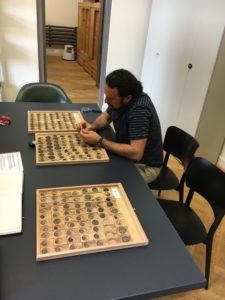
Epilogue
An expert pedagogue who adeptly guides learners in the process of discovery through interesting, though at times unfamiliar, territory, it is no surprise that in 2012 Theophilos was awarded the Australian Government Citation for Outstanding Contributions to Student Learning for the adoption of innovative and exciting approaches to teaching biblical languages and history. Theophilos is currently writing an innovative textbook for Hellenistic Greek that utilizes inscriptions and papyri – employing actual images in addition to transcriptions – for teaching vocabulary, morphological forms and points of grammar. It is my understanding that it will be possible also to harvest the textbook for illustrations, for use in coordination with more traditional textbooks. Godspeed, Michael – we look forward to this resource for ancient Greek learners and teachers!

Jordash Kiffiak is a research associate at the University of Zurich. He is currently writing two monographs. One investigates whether Jewish or non-Jewish miracle stories provide a better context for understanding the response motif found in the Gospels. The other addresses the issue of pseudepigraphy in 2 Baruch. He is the author of Responses in the Miracle Stories of the Gospels: Between Artistry and Inherited Tradition (Mohr Siebeck, 2017) and Living Christian Aramaic: Introduction Part 1 (Biblical Language Center, 2017), a textbook for beginner’s Syriac, co-authored with Niek Arentsen and Randall Buth. Since 2007 he has taught ancient languages – biblical Hebrew, Syriac and, especially, Hellenistic Greek – using innovative, communicative approaches at various institutes, including the University of Zurich.
Abgelegt unter: Reports
9. March 2018 |
Christoph Heilig |
Keine Kommentare
This post was published contiguously on the Logos Academic Blog.

Introduction
Two weeks ago, Tavis Bohlinger wrote a blogpost in which he encouraged students and scholars of the New Testament to focus on the “common dialect,” ἡ κοινὴ διάλεκτος of the Greek language—that is, the Greek spoken roughly between 300 BCE and 300 CE. In the German-speaking sphere, from which I come, many students of theology still learn “Classical Greek” as it was used between 500 and 300 BCE (well, at least the Attic dialect of that time).
I really appreciate Tavis’ emphasis, because it is my impression that many students have a hard time transitioning from Plato to Paul—and far too often you can even find comments in German scholarly publications that have a solid basis in the grammar of Kühner and Gerth—but not in actual language usage in the first century CE.
Tavis also suggested a strategy for mastering Koine, which among other things included “reading through” Greek grammars. In response, Vinh T. Nguyen argued that every grammar has its time and place. Accordingly, he suggested that it might actually be more confusing than helpful to read different treatments on the same topic from grammars that stem from different backgrounds. I think this is a valid concern—though I have to confess that I find Vinh’s periodization and implicit ranking of grammars rather astonishing. The assumption that the Greek verb does not encode temporality grammatically serves as a kind of litmus test for a grammar that is said to belong to the “modern-linguistic” period—even though this position is advocated mostly by NT scholars (Porter, Campbell) and is not shared by most linguists (e.g., Adrados, Duhoux). Does this agreement with the linguistic consensus disqualify a grammar such as the one by Heinrich von Siebenthal from being “modern-linguistic”? (On this issue, cf. also the blog post by Wayne Coppins, who translates a passage from Heinrich von Siebenthal’s grammar; for the Logos-version see here.)
Besides this quibble, I am also not so sure whether Vinh actually succeeds in pointing to a constructive alternative after having “dethroned” grammar. The “important monographs on Greek” also have a specific research context in which they emerged. And even though NT scholarship has profited greatly from the research done primarily in an evangelical, North American context, I am also often surprised to see how unquestioned certain assumptions from this research tradition find their way into the exegetical literature.
Also, Vinh quotes a great formula (“Knowledge + Practice = Skill”), but I am still not sure what a student of the NT is actually expected to practice (presupposing monographs and contextualized grammars provide the knowledge). In any case, the exchange between Tavis and Vinh has made me think about my own engagement with the Greek language and whether I could point to some specific strategies and tactics that turned out to be helpful for myself and that might, perhaps, also be valuable to others.
So, how did I master Koine Greek?
Memorizing and Parsing
During my BA studies, I learned Koine under Heinrich von Siebenthal. In the second semester, he introduced his linguistic analysis of texts, but in the first semester our class followed the typical approach of learning vocabulary and tables with inflexion endings. I was never a huge fan of such a procedure because in the actual reading of Greek texts you usually do not want to recite the third declension simply to identify the function of a word on the page.
However, when I recently taught a Greek reading module at another institution and I noticed that the students were barely able to identify any verb form, I came to the conclusion that I might have been too critical towards this traditional approach. At least we were in the position to identify virtually every word form in the NT after two semesters, and it’s probably the fault of the wider curriculum (which didn’t include sufficient opportunities to practice our knowledge), and of my own laziness, that I haven’t profited sufficiently in the long term from all the memorizing.
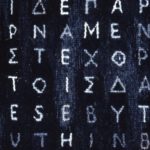
Translating
Interestingly, with regard to learning syntax, we followed a slightly less traditional path. We used a textbook that Heinrich von Siebenthal had written based on a method by Otto Wittstock. It makes use of insights from simultaneous translating of modern languages and aims at teaching students to learn to read Greek texts in way that is similar to the procedure of professional interpreters. This approach requires memorizing a lot of rules that have mainly to do with the differences between Greek and German syntax. Thus, there is a heavy emphasis on the target language, which is not too helpful in achieving “understanding” (as Vinh calls it). On the other hand, the approach ensures that you actually learn the relevant Greek syntax (i.e., those aspects that might actually cause some problems in understanding because of your mother tongue, which, whether we like it or not, will always influence our perception of the foreign language we are dealing with.
Living Koine
Due to my dissatisfaction with my Greek language skills, I continued to keep my eyes open for other approaches that might get me to a point that I deemed desirable. I had been using the “reconstructed” pronunciation by Randall Buth for some years already, when I met Jordash Kiffiak in Zurich. Jordash had been involved in the development of the approach and the teaching material and had been teaching Koine as a spoken, living language for quite some time in different contexts. My wife and I encouraged him to do a class for the theology students in Zurich as well, and had the chance to participate ourselves and see how this pedagogical approach might work in an academic setting. (He had already presented his method a few months earlier, and I have written about this workshop here).
On the one hand, this experience confirmed my suspicion that there are many advantages in learning word forms and basic collocations through hearing, speaking, and acting. Such a procedure allows for a more natural segmentation of grammatical information versus learning whole declension paradigms without any pragmatic context. I still think there is a lot of potential for teaching Koine this way.
On the other hand, the desire to remain as much as possible “in” the Greek language seems to also put a substantial limit on how fast you can progress with students and what kind of level you can achieve within the time that you usually have for teaching Greek at universities or seminaries. To be fair, there is some teaching material that aims at achieving some kind of fluency, but in practice the results one can expect is probably closer to what one might learn of a modern language during a one-semester stay in another country—or, rather, what one might learn during such a stay if you only talked to a single person. The diversity of Koine Greek appears in quite unified form in the living-language approach. For example, after Jordash’s class we tried Christophe Rico’s “Speaking Ancient Greek as a Living Language.” In the very first session, students are supposed to internalize ἆρα as a question particle—which doesn’t prepare you at all for dealing, for example, with questions and interrogative particles in the New Testament.
Despite my initial enthusiasm, I have actually become quite skeptical of whether teaching Koine as a living language will help students to “master” Greek. In other words, I am quite sure that the “communicative” teaching material I have seen so far will not get students to a point where they would know the language well enough to offer a satisfying descriptive account of their understanding of the text. To be sure, all else equal, students who have had a semester of Koine as a living language will most certainly be able to extract more information from a Greek passage and to do it faster than students who learned through the traditional approach. This is not, however, what we are usually after in exegesis and, in my opinion, the result is also not close enough to fluency to constitute a valid alternative to this goal.

Modern Greek
All this emphasis on “speaking” leads me to another aspect of my journey with Greek: I have been visiting Greece almost every year since I was a little child. Thus, learning Modern Greek had always been on my agenda to a certain extent. I actually intentionally tried to keep it separate from my study of Ancient Greek to avoid mixing up forms and meanings. The use of the reconstructed pronunciation seemed to help this segregation.
But then, when I also had to speak Koine in Jordash’s class, this barrier collapsed and I began to blend both phases of the Greek language in an ugly manner, to the point that I could hardly conduct an intelligible conversation in Modern Greek. Ultimately, dropping the reconstructed pronunciation actually helped me tremendously. I still make many anachronistic mistakes (that cause my students to doubt my abilities and the Greek waiter to do the same with my sanity). Still, allowing my mind to accept and explore the continuity between Ancient and Modern Greek, I have the impression that my reading of Koine texts has profited substantially.
Most NT scholars probably have some experience with Modern Greek and I definitely encourage students to follow this example. Besides my personal interest in the culture and language of the Greek nation, I think it’s a matter of respect to have some basic knowledge of how Greek is used today—not so much because it would allow us to take into account Greek scholarship by Greeks (although that would be commendable), but simply because we can easily lose sight of the fact that we are dealing with Greek literature on a daily basis. In other words, we are constantly commenting on cultural artefacts that are part of a tradition that still has 13 million native speakers today.
I wouldn’t go so far as to call it a matter of “basic human decency” since such claims have recently revealed a certain potential to backfire, but I do have the impression that it wouldn’t hurt NT scholarship if we made ourselves more aware of the fact that in a certain sense we (speaking of non-Greek biblical scholars) are actually dilettantes in the area of our professed expertise. And the kind of humility that comes from the humiliation of trying to communicate in Modern Greek with people who actually speak that language might help prevent us from some of our stupidest assertions of what is or is not “possible in Greek.”
This line of reasoning is also, by the way, my main argument for favoring the use of the modern pronunciation of Greek in NT scholarship. (Since there is no “historical” pronunciation to be reconstructed anyway, it seems perfectly fine to follow political reasoning. But this is probably a topic for another post … )
So, did I finally master Koine Greek once I had realized how much my (quite limited) knowledge of Modern Greek might actually contribute to my interaction with Ancient Greek texts? Unfortunately, no. On the one hand, learning Modern Greek is a continuous struggle on its own for me. In addition, my hopes that mastery of that stage of the language would automatically make me an expert in Koine Greek received a severe setback: I showed Koine texts to Greek native speakers (who were not at the same time also Biblical or Classical scholars) and they were not able to make much sense of what they were presented with. This might be different for people who grew up with the Katharevousa used in the 1960s in Athens, but for young Greeks, the distance between their language and the Koine seems to be much bigger than Caragounis in his enthusiastic “Streitschriften” seems to be willing to admit.[1]
Text Grammar
How, then, did I finally master Koine Greek? The short answer is that I haven’t. However, there is one further aspect that I found helpful and that combines both Tavis’ insistence on “working through” a Greek grammar to achieve grammatical knowledge and Vinh’s plea for “practice.”
When I researched narratives and narrative sub-structures in the letters of Paul, I had to deal with the question of how Paul creates “temporal order” (which is regarded as constitutive or at least essential for narrativity by all narratologists). To this end, I applied Heinrich von Siebenthal’s text grammar to the Pauline corpus.
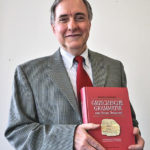
Note that in the English-speaking sphere in discussions of discourse analysis, “text grammar” is often associated with an outdated, transphrastic understanding of the category of “text.”[2] By contrast, Heinrich von Siebenthal follows the “integrative” text model of the text linguists Christina Gansel and Frank Jürgens, who integrate pragmatic considerations in their definition of textuality and, thus, define “Textgrammatik” as “pragmatic grammar.”[3] It is my fundamental conviction that, just as we make use of insights into Greek syntax for the analysis of Greek sentences in the NT, we should also take into account the current state of text-grammatical research when dealing with the structure of whole texts.
For the present purpose, I do not want to explicate this more general argument but rather focus on how I personally benefited from working with the relevant paragraphs in Heinrich von Siebenthal’s grammar (§297–354 in Griechische Grammatik zum Neuen Testament = GGNT). In explicating how coherence is achieved in texts, von Siebenthal builds on categories also used in the “Duden,” the standard German grammar,[4] to classify sense-relations between propositions. However, these basic options for how propositions are connected semantically are not dependent on a specific language (cf. GGNT 352a). So my systematic analysis of temporal “connexions” (pairs of propositions) in the letters of Paul was refreshingly different from other lines of reasoning and learning I had followed earlier.
For example, I began with a category like “simultaneity,” discovered the many differentiations that can be made within this broader concept, and then inquired where and how Paul had realized it in his letters (and how he differed from other authors of his time). For me, this was very different from my usual way of “practicing” Greek, (i.e., translating or reading/speaking/understanding). At the same time, it differed from my past attempts to build my “knowledge” (by going through sections on specific questions of Greek syntax in grammars). And in both ways this new approach seemed to be more fruitful.
With regard to “knowledge,” I realized I was suddenly able to memorize aspects of Greek syntax that I had often read before but was not able to keep in my head. For example, when I approached the subcategory of “repetitive simultaneity” (cf. GGNT 330a), for the first time I had a place to store information about the iterative optative in Classical Greek and the corresponding use of Aorist and Imperfect Indicative in subordinate clauses in the Koine (the so-called “hellenistische Nebensatziterativ” (GGNT 211i; cf. BDF 367). At the same time, I learned something about German as well—for example, that the use of the conjunction “wenn” with preterite always has in view the same constellation (see Duden 1769).
So in the end, choosing text grammar as your point of departure will in fact cause you to (re-)consult treatments of Greek syntax (i.e., to go from temporal connexions to temporal clauses and adverbial participles, from conditional connexions to conditional clauses, etc.) Also, this approach will constantly drive you to dictionaries and searchable text corpuses, to be sure, not the least because the list Heinrich von Siebenthal offers (even if supplemented by comparable English literature) is not complete (cf. in particular GGNT 325b).
At the same time, I think from the perspective of “practice” this was also a beneficial exercise. I had—as Tavis encourages to do—annotated specific Greek writings before, going through passage indexes in Greek grammars and reading through sections that I thought might be relevant for problems in the text.[5] When I read the same passage again now, I often remember what I had looked up and it’s easier for me to understand the text in question. But I could probably not say with certainty whether a similarly looking phenomenon in another text belongs to the same category or whether it should actually be treated differently. By contrast, whenever I now encounter an ὅτε in a Greek text, I remember the different ways this word can be used in temporal contexts and I have a broader context that allows me to evaluate the verse in question.
To be sure, approaches to teaching Greek as a living language also prioritize practicing the expression of specific ideas (over against translating German or English phrases). However, at least in my perception, there is a lack of emphasis on the variegated options for expressing the same idea and the slight pragmatic differences between them. By contrast, if you begin with von Siebenthal’s text-grammatical categories, you will soon see, on the one hand, how individual authors associate specific connectors and alternative constructions for making subtle semantic distinctions and, on the other hand, where stylistic preferences and contextual factors influence the expression level of the text.
For example, Matthew prefers the adverb τότε to introduce a new event in a sequence in a series of main clauses. While Matthew displays a stylistic preference for this adverb also in comparison to the other gospels, it is striking that Paul almost never uses this mode of narration in general (i.e., ἔπειτα and εἶτα also appear only sporadically). In his case, the pragmatic dimension of the communication often seems to “relieve” the Greek syntax:[6] Paul can often use prepositional phrases with infinitives or action nouns because in the communicative context of his letter he can presuppose that the readership already knows the “story.” The function of the text is not to inform about events heretofore unknown, but to stipulate a reevaluation of these events or even to encourage action.[7]
Conclusions
I haven’t mastered Koine, and I don’t think there is any chance that I will do so in the near future. My constant dissatisfaction with my own skills relating to the Greek language have led me, however, to reflect more than once on how such mastery might be achieved or at least approached in the best manner. Many scholars have succeeded in developing an impressive proficiency in Koine Greek. Yet, the dominating impression for me is that learning Greek remains a frustrating experience even for many of the most diligent students.
The communicative approach certainly has some potential for offering a remedy for this unfortunate situation. However, in my opinion, the integration of this pedagogical paradigm with a teaching process that enables students to also offer a linguistically valid, descriptive account of their interpretation of texts so far remains unaccomplished. Most importantly, I expect that for such a didactic reboot to take place, fundamental changes would have to be made to the curriculum at universities and seminaries in general. 300 hours of study is not enough time to teach Greek in a way that students will fully internalize word forms, collocations, and meanings, while also offering them tools for analyzing the syntax and larger text structure. I would greatly appreciate hearing from people who have experienced efficient methods and contexts that helped them to achieve a satisfying mastery of Koine Greek in less than a few decades (with the recognition that “mastery” is itself a relative term). I say this recalling that Erasmus boasted to a friend that he had mastered Koine is just two years, at that at the age of 34.

In the meantime, I hope this blogpost—and the recommendation to focus on Modern Greek and to use text-grammatical categories as point of departure—might turn out to be helpful to some who find themselves in a situation similar to mine: students and scholars of the New Testament who are frustrated that they had not better learnt Greek in the first place and who do not have the time and opportunity to begin all over again (or who are tired of attempting to relearn once again), but who would like to have some tools at hand to at least improve certain areas of their linguistic capabilities relating to Koine Greek.
[1]Cf., for example, Chrys Caragounis, The Development of Greek and the New Testament: Morphology, Syntax, Phology, and Textual Transmission, WUNT 167 (Tübingen: Mohr Siebeck), 56, grumbling about the “solution” of the Language Question and pointing to “non-Greek vocables, which, often, are”—so he claims—“not understood by ordinary Greeks.”
[2]See, e.g., Stanley E. Porter’s “Discourse Analysis and New Testament Studies: An Introductory Survey,” in Discourse Analysis and Other Topics in Biblical Greek, ed. Stanley E. Porter and D. A. Carson, JSNTSSup 113 (Sheffield: Sheffield Academic, 1995), 20.
[3]Christina Gansel and Frank Jürgens, Textlinguistik und Textgrammatik, 3rd ed., UTB 3265 (Göttingen: Vandenhoeck & Ruprecht, 2009), 113.
[4]Duden: Die Grammatik, 9th ed. (Berlin: Dudenverlag, 2016), §1758ff.
[5]By the way: BDR and BDF have a great Scripture index. If you are working with GGNT, I suggest you also buy the Neue Sprachliche Schlüssel from Haubeck and von Siebenthal (for the Logos-version see here), which is not only great for beginners but also helpful as a key to von Siebenthal’s grammar.
[6]Cf. Gansel and Jürgens, Textlinguistik, 174, saying „dass Pragmatisches die Anforderungen an die Syntax entlastet.”
[7]For a first orientation concerning the linguistic concept of text function, see GGNT 302.


Christoph Heilig is the author of Hidden Criticism? (Fortress, 2017) and Paul’s Triumph (Peeters, 2017). Additionally, he has co-edited (with J. Thomas Hewitt and Michael F. Bird) God and the Faithfulness of Paul: A Critical Examination of the Pauline Theology of N. T. Wright (Fortress, 2017). In his most recent project, he discusses the importance of “stories” and “narrative substructures” for understanding Paul’s letters.
Abgelegt unter: Current Discussions⋅ Hints to and reviews of German literature you might otherwise miss
21. December 2017 |
Christoph Heilig |
Keine Kommentare
Since we are approaching Christmas and, thus, recitals of Luke’s story of Jesus’s birth all around the world, it seemed appropriate to me to draw attention to the recent publication of volume 2 of the English translation of Michael Wolter’s commentary on the Gospel of Luke.
The translation of Wolter’s commentary thus is complete now!
You can buy vol. 2 here and vol. 1 (published in 2016) here.
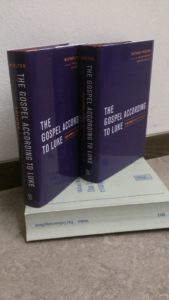
For my comments on the commentary as a whole, see my earlier blog post. Make sure you also check out the various posts on this work by the main translator, Wayne Coppins. If you are interested in translations and the importance of “bridging the German-English-divide” in New Testament studies in general, you might like this summary of a workshop by Wayne here in Zurich.
I am also pleased to see that the commentary has already received a very warm reception in the blogosphere: Besides Larry Hurtado’s recent post see Samuel Roger’s very thoughtful assessment of the commentary. Also, Scot McKnight has selected it (with two other works) as the best commentary of the year!

Christoph Heilig is the author of Hidden Criticism? Methodology and Plausibility of the Search for a Counter-Imperial Subtext in Paul, (Mohr Siebeck, 2015) and Paul’s Triumph: Reassessing 2 Corinthians 2:14 in Its Literary and Historical Context, (Peeters, 2017). Additionally, he has co-edited (with J. Thomas Hewitt and Michael F. Bird) God and the Faithfulness of Paul: A Critical Examination of the Pauline Theology of N. T. Wright (Fortress, 2017).
Abgelegt unter: From us or people associated with us
13. September 2017 |
Christoph Heilig |
6 Kommentare
1. Empire and the “Traditional” Paul
The notion of “empire” regularly pops up in discussions both in the church and in academic theology. One the one hand, there is the constant consideration of how Christianity relates to present-day power structures, the state, or individual politicians. On the other hand, this conversation often includes reference to biblical literature – and thus raises the historical question of how specific authors of the Old and New Testament relate to the empires of their day. (Cf., for example, this volume). The apostle Paul seems, at least at first sight, not to offer a particularly critical perspective on the Roman Empire of his own days: only a few years before Christians were burnt alive as torches by Nero in Rome, his advice to the congregations in that city (Rom 13:1–7) seem to be marked by submissiveness and even theologically motivated respect!
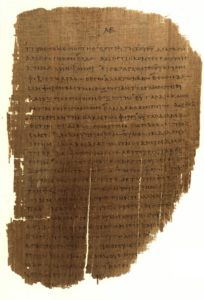
Rom 13:2–12 in P46
And in a certain sense, so earlier generations of scholars, this attitude was also quite understandable. As a Roman citizen (if he was one), Paul knew the benefits of Roman rule from his own experience. And if there hadn’t been a Roman peace, the famous pax Romana, and if the Romans hadn’t invested so much in the infrastructure of the huge area over which they ruled – how would evangelism even have been possible for the travelling apostle? So, at first sight, Paul and his writings do not seem to be an especially promising source for “anti-imperial” notions. Rather, he seems to be a forerunner for the church father Eusebius, where such a positive stance towards the Empire climaxes in it being regarded as an instrument of God that prepared the way for the gospel.

Via egnatia
2. Coded Criticism?
This picture, however, has been questioned by some scholars over the last two or three decades: What if, so they ask, on the basis of these explicit statements in a single passage we have misread Paul through the centuries by ignoring the fact that there are, in fact, plenty of implicit critical remarks directed against the Roman Empire and, specifically, against the figure in which it was focused, Caesar? After all, so this line of thought, Paul couldn’t have been pleased with the imperial cults that sprang up in virtually all the cities Paul visited during his missionary travels after Octavian had been named “son of a god” in light of the the deification of his adoptive father (and great uncle) Gaius Julius Caesar.
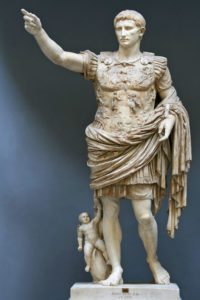
Augustus of Prima Porta (20-17 v. Chr.), from the Villa Livia in Prima Porta, 1863
Two scholars in particular, Neil Elliott and N. T. Wright, have propagated this new idea in multiple publications, building on two basic assumptions:
- It would have been dangerous to criticize the Roman emperor publicly.
- Paul wanted to avoid persecution and, thus, needed a way to state his criticism while remaining safe.
Thus, so the conclusion, Paul expressed his criticism only “between the lines.”
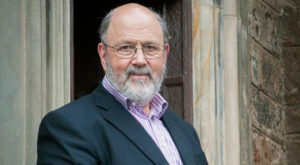

If Paul’s criticism, his real intention, is however located not on the surface of the text, but rather in its subtext, how could we dig it up? After all, it seems to be the nature of something that is “hidden” that it can’t be seen. Hence, we are faced with the question of how we could possible decrypt this “coded” criticism and how we could unveil what is covered over by centuries of misled interpretation? Both Elliott and Wright make recourse to a list of seven criteria that had been suggested by the Pauline scholar Richard B. Hays for the detection of subtle allusions – so-called “echoes” – of the Old Testament in the letters of Paul.
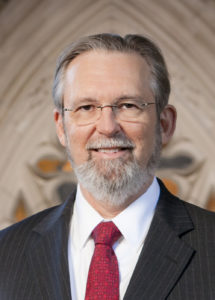
These criteria are (cf. Hays’s book Echoes of Scripture in the Letters of Paul, pp. 29–30):
- Availability: Was the supposed source of the echo available to the author/the original reader? The Hebrew Scriptures are assumed to be known to Paul on the grounds of many explicit quotes. On the other hand, this shows that Paul expects his readers to be familiar with this material.
- Volume: The “volume” is mainly determined by the degree of explicit repetition of words or syntactic patterns. But there are other factors, such as the question of how important the source text was in the Jewish canon and how much the echo is emphasized.
- Recurrence: How often does Paul quote the same scriptural passage or allude to it.
- Thematic Coherence: This criterion analyses how well the supposed echo fits into the flow of Paul’s argument or with other quotes in his letters.
- Historical Plausibility: Is it historically plausible that Paul would have intended the effect of the echo and that his readers could have understood it?
- History of Interpretation: Has the echo been identified before? Since discoveries could be new and meanings lost for a long time, a negative test result is not a criterion for exclusion.
- Satisfaction: This criterion asks questions like: Does the new reading make sense? Does it shed light on the discourse? Does it offer a good explanation for the supposed intertextual link?
If it is possible to identify echoes of Scripture in Paul’s writings with this method, why not – so the two scholars – also echoes of the Roman ideology?

Seurat: L’écho
3. Criticism of the Idea of Hidden Criticism
While this line of argument won the support of a substantial number of scholars, many (see, e.g., Seyoon Kim on “Christ and Caesar”) have remained skeptical about whether this was a feasible exegetical procedure, questioning whether we might not rather read an anti-imperial attitude into the text in an uncontrolled manner. Most notably, John M. G. Barclay put forward this critique in a prominent debate with Wright at a SBL meeting (you can listen to the audio here and here ). Barclay later published his remarks in revised form in his collection of essays Pauline Churches and Diaspora Jews (Eerdmans has published a inexpensive reprint of the original Mohr Siebeck edition, which can be bought here). As he puts it in the title of that chapter, in his opinion the Roman Empire was simply “insignificant” for the apostle – and the fact that we don’t find explicit criticism in his letters is simply due to the fact that Paul didn’t even deem the Empire worthy of any special attention (both positive and negative), focusing rather on the real enemy, i.e., Sin and Death.
4. Assessing the Current Methodology
4.1. What Makes a Hypothesis Plausible?
How could this dispute be decided? First, one could evaluate the question of whether Hays’s seven criteria are actually fulfilled in the case of “echoes of the Empire.” Second, it would also be possible to focus, more fundamentally, on the question of whether this set of criteria is even applicable to the realm of Roman ideology. This route is taken by Barclay. Both of these approaches to checking the validity of the paradigm by Elliott and Wright presuppose, to be sure, that Hays’s criteria are in fact a good set of tests for the context they were originally designed for. But is this assumption justified or do we need to build on a different methodological foundation?
If we encounter a peculiar formulation in one of Paul’s letters and we argue about whether it is due to an intertextual link (be it to Roman ideology or Scripture), we are proposing a hypothesis and making a claim that it is better supported by the evidence than its alternatives (e.g., chance). But what is it that makes a hypothesis “better” in the first place?
There is a very intuitive answer to this question. From a good hypothesis we demand, first, that it explains the evidence in question well. In other words, the hypothesis has to have a good “predictive power,” an aspect that we can estimate by answering the question: If the scenario involved in the hypothesis were true, would we actually expect the phenomenon that we are now trying to explain (i.e., the specific phrase)? If I notice that my car has a flat tire, I will search for explanations that would make the damage understandable. There are scenarios that might be very plausible in themselves – e.g., that I ran over a snail (I might still see the crushed shell sticking to the tread) – but which do not seem to be a likely cause for the damage I observe.
However, this aspect of predictive power alone cannot suffice as a criterion. For we all know that it is easy to come up with a multitude of explanations for any circumstance that would make the occurrence of the observed event (a flat tire, a wet road, a specific formulation in the text, etc.) appear probable – but which are incredible to us because they presuppose certain assumptions that we are not willing to share, such as the idea that an alien visited our planet in order to destroy my tire with a laser sword. After all, you might already have noticed, that it is a hallmark of conspiracy theories that they beautifully explain all kinds of observations – but they do so at the cost of making assumptions that many of us judge to be improbable (that the US government would be willing to kill the people in the World Trade Center, for example).
4.2 Introducing Bayes’s Theorem
Thus, the second aspect we have to take into account when we evaluate competing hypotheses is the question of whether the parameters they presuppose are plausible in light of our background knowledge. Even if my damaged tire looks perfectly like what one would expect as the result of a stabbing mixture of E.T. and Darth Vader, I might still reject this explanation on the basis that I am not convinced that a potential perpetrator of that kind even exists.
You might ask, quite appropriately, how these considerations concerning a hypothetical alien might relate to Hays and his criteria. A first step towards an appropriate answer is that a notable feature of the comparison of different hypotheses is that it often takes place in probabilistic terms. In other words, usually we regard a hypothesis to be superior over its alternatives if it is more “probable” in our eyes. By this we commonly mean that we would be willing to bet (varying amounts of) money on its truth. From this circumstance we can move on and observe that there is a relatively simple mathematical theorem (by the mathematician Thomas Bayes; note that the authenticity of the picture is debated) that describes how conditional probability is to be calculated.
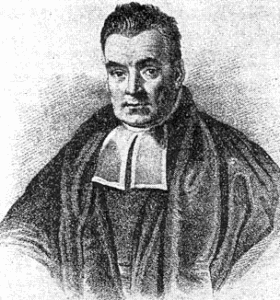
This, in turn, can be applied also to the calculation of probabilities of different hypotheses in light of (i.e., being probabilistically dependent on) new evidence – and this is of course of enormous importance for the evaluation of Hays’s criteria!
4.3 Bayes’s Theorem and Biblical Exegesis
To be sure, when dealing with historical matters, we usually don’t have precise numbers with which we could feed Bayes’s theorem. However, what is helpful about it indeed is that it shows us exactly how these two aspects – I call them “explanatory potential” and “background plausibility” – are related to each other. In particular, it is clear because of the theorem that both aspects need to receive equal weight when we assess the validity of explanations for a specific phenomenon.
It is immediately obvious why this is important for the exegesis of biblical texts: For a complete argument, it does not suffice, on the one hand, to find an explanation for a peculiar phrase that would make it very probable if it were true. Together with Theresa Heilig, I have argued elsewhere that this is a potential danger of proposals that rely on “abduction.” For example, it stands to reason to assume that if Paul’s thinking was shaped by a complex multi-layered narrative on the level of his worldview, this might explain many of the features of his text. However, we also have to critically assess the question of whether it is even plausible to assume that this mental construct ever existed.
On the other hand, falling off at the other side of the horse, biblical scholars often make the reverse mistake of discovering a new “background” for a specific wording and then spend a great deal of energy demonstrating that this context was actually available to Paul (i.e., the hypothesis has a good background plausibility), while failing to show that Paul’s actual word choice is what we would expect if he had had indeed this context in mind. To give just one example, some scholars have suggested that when Paul uses the verb θριαμβεύειν in 2 Cor 2:14, he doesn’t think of the Roman triumphal procession but of a pagan epiphany procession. Now, Paul certainly knew about these kinds of celebrations. However, what one must not overlook is the fact that there were plenty of lexical options at his disposal for expressing precisely that notion – and θριαμβεύειν was not one of them! For details on this, see the work discussed in this post. Interestingly, a statistician who has reviewed this work confirms that in his experience, “explanatory potential is often neglected in exegetical studies relative to background plausibility.”
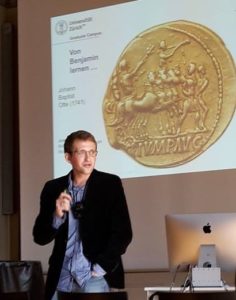
4.4 Analyzing Hays’s Criteria against the Backdrop of Bayes’s Theorem
Now, just as Bayes’s theorem offers a framework for evaluating specific exegetical proposals, it can also offer us a “meta-criterion” for assessing suggested sets of criteria for the identification of certain features. A set of “criteria” – in the sense of a heuristic tool – is good if it is a fair projection of the equal consideration of both explanatory potential and background plausibility. So, what happens if we analyse Hays’s criteria against the background of these two parameters? The result looks, I would suggest, like this:
- Background Plausibility
- “Availability” of the source text for the author (including parts of “History of Interpretation”)
- “Historical Plausibility” of the achieved effect in the framework of the worldview of author and recipient (including parts of “History of Interpretation”)
- “Thematic Coherence” with the immediate literary context
- “Thematic Coherence” with other allusions by Paul and “Recurrence” of the motif
- Explanatory Potential = “Satisfaction” (including “Volume” of the potential echo)
That this is not unproblematic should be immediately obvious:
First, based on a list of seven criteria, one would probably not think that one of them – “satisfaction” – should actually bear half the weight of our entire assessment. Thus, there is a real danger that anyone who uses this set of criteria will underemphasize certain aspects. There is an associated problem: Hays’s approach is cumulative. So the failure of one test might be balanced out by the fulfilment of other criteria. There is good reason for such an approach, because for Hays the criteria function as heuristic tools, not as all-or-nothing touchstones. However, there is no control mechanism built into the set itself to prevent illegitimate compensation. If “satisfaction” falls through completely, for example, how many of the other criteria do you think have to be fulfilled? 2, 4, or perhaps 6? The answer is: it doesn’t matter. If the explanatory potential is zero, so is the overall-probability.
Second, rather than being independent, some of Hays’s criteria seem to be subordinate to one or several of his other criteria. For example, whether the assumption of an intertextual echo explains the text in question well (i.e., whether we would expect that wording if the hypothesis were true) depends, after all, on the “volume.” Accordingly, if we are dealing, e.g., with a long string of words, this lowers the explanatory potential of competing hypotheses such as chance. So there is also the danger associated with this set of criteria that we might make an argument on the basis of the quantity of fulfilled criteria even though this number is actually the result of an inflation of only a single criterion, thus leading to on overemphasis on certain aspects.
Third, it seems doubtful whether these criteria actually cover all the relevant evidence. In other words, what tells us that all the important parameters that make up the background plausibility of a hypothesis are taken into account once we have taken into account Hays’s criteria (with the exception of “satisfaction”)? Part of the problem is, that the criteria in themselves do not specify which specific data need to be considered to perform the individual tests. For example, what makes the hypothesis of “hidden criticism” of the Roman Empire historically plausible? The criterion itself does not tell us in any detail. Thus, I think the third danger with using Hays’s criteria (regardless of the source in question for the postulated intertextual link) is that it is rather easy to claim that a specific area of evidence is covered (most notably “historical plausibility” and “availability”) because we can point to some data in our background knowledge that would support the assumption of such an intertextual reference, even though other evidence might contradict this. Let’s take as an example the thesis that Paul’s use of the “son of God” title for Jesus is a challenge to the Roman emperor. Now, the fact that the inscription divi filius occurs on coinage certainly belongs to the area of “availability” – but does the fact that we have considered some evidence that is relevant to this test also imply that this box can be regarded as ticked?
To be sure, you can use Hays’s criteria in a heuristically fruitful way – namely if you intuitively attribute, first, the right portion of significance to the individual criteria and if you, secondly, make sure that you do not use the label of a criterion as an excuse for not making your own reflection on what kind of evidence needs to be taken into account to evaluate it. The problem, of course, is that it is well known from psychological experiments that our intuition does not serve us particularly well in such matters… It is of course possible to cultivate this intuition and there are, thus, certainly many sober judgements that are made on the basis of Hays’s criteria, especially by Hays himself. However, from a methodological perspective their function can then best be described as “inspirational” (i.e., stimulating the exegete to take certain important aspects into account), while the correct result of the inference is due to the independent attribution of the appropriate evidence to the individual criteria and to the right attribution of significance to them. In light of the problems mentioned above – which become obvious when the set of criteria is analysed against the background of Bayes’s theorem – it could be said that the inference would then be correct despite – and not because – of Hays’s criteria, which have at least the potential to mislead.
But is there a better way forward?
5. An Alternative Methodological Approach
Let’s try to figure out an alternative approach that does not rely on Hays’s criteria but rather uses the basic structure of Bayes’s theorem as its point of departure.
The explanatory potential of the “echo-hypothesis” has, of course, to be evaluated on a case-by-case basis. The question of whether the assumption of a subtle intertextual reference explains a specific phrase needs, after all, to take into account this specific wording. For example, we could investigate which Greek lexemes we would expect if Paul wanted to allude to the Roman slogan pax et securitas (“peace and security”) – and whether the answer corresponds to his actual word choice in 1 Thes 5:3 (εἰρήνη καὶ ἀσφάλεια).
But even if both questions were given an affirmative answer, we would still be faced with the question of whether the background plausibility of this hypothesis would be high enough. If we read the work of those who criticize Elliott’s and Wright’s paradigm against the backdrop of our previous considerations, it becomes clear that these scholars actually claim that in light of our knowledge of antiquity, the background plausibility of the “echo-hypothesis” ultimately breaks down. If, however, the background plausibility of the hypothesis that Paul used the subtext of his letters to implicitly criticize the Roman Empire is negligible, even an explanatory advantage, be it small or large, wouldn’t really help the case of Elliott and Wright!
But how can we distinguish insignificant quibbles from paradigm-shaking objections? As we have already seen, reference to the (lack of) fulfilment of Hays’s criteria is only of limited value. Therefore, I suggest a somewhat different route: Let’s think again about the basic assumptions that the echo-hypothesis of Elliott and Wright makes: 1. It would have been dangerous to criticize the Roman emperor publicly. 2. Paul wanted to avoid this persecution. My suggestion is that it is possible to identify several “necessary conditions” that are connected with these two basic assumptions:
- Most fundamentally, this hypothesis presupposes that Paul’s letters were actually a matter of public discourse. (This is where the issue of “hidden” and “public transcripts” is relevant.)
- It is also presupposed that the rules of this public discourse, in the Roman Empire, sanctioned open criticism of certain aspects of its ideology.
- Moreover, it is a necessary condition that Paul knew that ideology.
- And, of course, this knowledge can only lead to criticism if he had a critical attitude towards it.
- Lastly, the actual expression of such an attitude in the subtext of Paul’s letters presupposed that the move to cover his critical remarks would fit the personality of the apostle.
As you might have noticed, these necessary conditions are successively built on one another. Thus, if the first assumption can be disproven, we don’t have – and should not – point to the fulfillment of subsequent conditions, because the background plausibility as a whole collapses. To me this seems to be a clear advantage of this approach – it offers a framework for academic discourse by allowing different scholars to precisely locate their disagreement with Elliott and Wright (assuming that they have good reason to disagree). Similarly, one could also criticize my own attempt to structure the debate by pointing to an additional consideration that ought to be located as “missing-link” between two of my suggested conditions.
If I have managed to provide a convincing argument to this point, then you might perhaps appreciate this potential contribution to the continuing dialogue concerning the question of the anti-imperial Paul. However, perhaps you might also be deeply interested in the question of what an assessment of this bottom-up set of necessary conditions of the echo-hypothesis would actually look like and to what result it might point: Is the Roman Empire really insignificant to Paul? Does the paradigm of a counter-imperial interpretation of Paul, as developed by Elliott and Wright, collapse if scrutinized through the lens one of the above mentioned considerations?
One way to satisfy your curiosity would be to buy this book, whicht has just been released by Fortress and which is currently on offer:
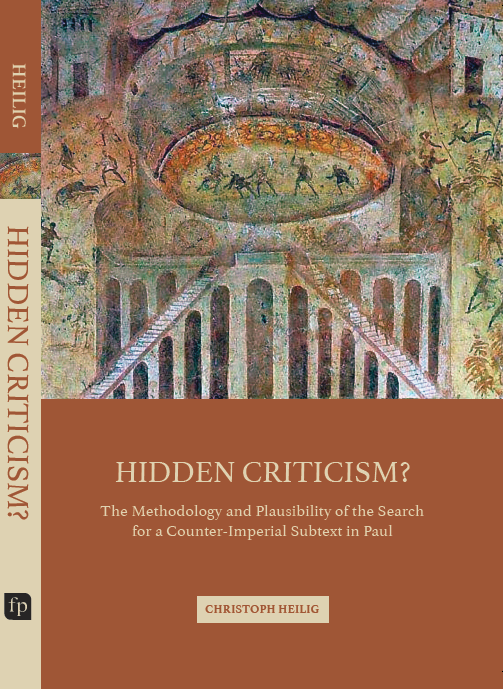
If this blog post hasn’t convinced you, perhaps these endorsements will:

If you (or your library) have a bit more money to spend and you wish to prioritize printing and paper quality, you might also consider getting the version that was published by Mohr Siebeck.
Christoph Heilig is the author of Hidden Criticism? Methodology and Plausibility of the Search for a Counter-Imperial Subtext in Paul, (Mohr Siebeck, 2015) and Paul’s Triumph: Reassessing 2 Corinthians 2:14 in Its Literary and Historical Context, (Peeters, 2017). Additionally, he has co-translated (with Wayne Coppins, the main translator and editor of the project) Michael Wolter’s The Gospel According to Luke and co-edited (with J. Thomas Hewitt and Michael F. Bird) God and the Faithfulness of Paul: A Critical Examination of the Pauline Theology of N. T. Wright (Mohr Siebeck, 2016).
Abgelegt unter: From us or people associated with us
11. September 2017 |
Jordash Kiffiak |
Keine Kommentare
What traditional influences lie behind the recurrent patterns of responses that are found in all four of the Gospels? In this second and final post on my recently published monograph, Responses in the Miracle Stories of the Gospels: Between Artistry and Inherited Tradition, I summarise the findings in the book’s second section. I described the contribution made by the first portion of the book, entitled “Towards Artistry,” in an earlier post. The analysis there makes it clear that the motif in question – descriptions of characters’ responses of feeling, speech, physical actions and so forth to miracles – is used with versatility and for a variety of purposes throughout each of the Gospels. Given the broad diversity in usage, it is remarkable that the Gospels still hold so much in common with regard to the responses. In the book’s second section, “Towards Tradition,” I investigate the possible reasons for the commonalities not only among Matthew, Mark and Luke (the Synoptic Gospels), but also among all four of the Gospels.
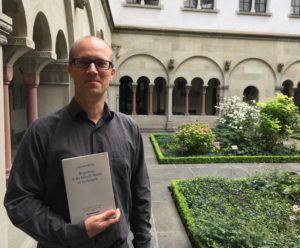
I examine first of all, in chapter six, the question of the interrelations of the Gospels, including possible literary source material and oral tradition specific to Jesus which informed the authors of the Gospels. Then, in chapter seven, I consider what sort of ancient story-telling patterns, more generally speaking, have likely influenced the formation and development of the miracle stories about Jesus.
Literary Dependence and the Role of Oral Tradition
Assuming the Two Document Hypothesis[1] – namely, that Mark and Q (a hypothetical literary source) were written independently and were both used by Matthew and Luke – I approach the question of literary dependence and the role of oral tradition on the composition of the Gospels from a number of angles, in the book’s lengthiest chapter, “The Interrelations of the Gospels” (chapter six). The more general considerations, involving statistical analysis, produce interesting results. For all four of the Gospels a statistically significant distinction between epiphanic stories (such as the stilling of the storm or the angelophany at the empty tomb) and other miracle stories (notably healings and exorcisms) is seen on the basis of a story’s setting and the kind of characters responding.[2] In all of the Synoptic Gospels a further criterion for the distinction is the kind of feeling contained in the response (fear versus amazement).[3] “In private settings followers of Jesus respond, typically with fear, to epiphanies, while in public contexts other people respond, often with amazement, to healings, exorcisms and other such miracles” (pp. 656–657). These data, taken together, offer a very strong indication that the patterning found in the gospel miracle stories did not arise by chance. Rather intentional human activity is responsible for bringing the patterns about.
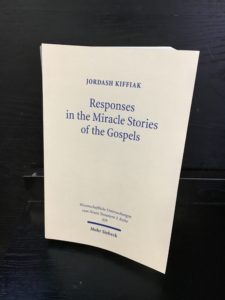
What sort of influences might be responsible for the intricate patterns in the miracle stories throughout the Jesus tradition? Literary dependence alone cannot reasonably explain the results of the statistical analysis, assuming the Two Document Hypothesis and even the Fourth Gospel’s direct or indirect use of one or more of the Synoptics. For the differences of content between John and the Synoptics – John hardly follows Mark or the other gospels closely, especially for the miracle stories – makes the similarities of story-telling patterning stand out like a sore thumb. “The resulting picture of the Johannine composer’s editorial procedure becomes too difficult to swallow.” (p. 602).
It is much more reasonable to assume that the common patterning arose, at least in part, from story-telling conventions in the oral tradition about Jesus. The impact of this oral tradition is widely felt, exercising influence on Mark, Q, John and the materials unique to Luke and to Matthew. The significance of the indebtedness to such tradition is all the more striking, given the Gospels’ tendencies towards variation, even artistry in the employment of responses – a point drawn out at length in the preceding chapters. In addition to (and at various points potentially more important than) the influence coming through lines of literary dependence, the common patterning in the Gospels likely results from each author’s familiarity with it either as an audience member when oral tradition was performed or as an oral performer.
While much of New Testament scholarship has relied on inadequate – and often outdated – models of oral tradition, the picture of the place of miracle stories in the Jesus tradition has remained hazy. But significant advances have been made in recent years. My analysis draws especially on the work of Eric Eve and Rafael Rodríguez.[4] Using various concepts from modern theory about oral tradition, also social memory, I am able to explain the statistically significant features of the responses studied, as well as other aspects of the responses that are held in common by the Gospels.
In essence, the new approach to oral tradition argues that in oral performance the meaning inherent in traditional content, also forms, is more important than any meaning potentially conferred on it through the innovation of a particular oral performer in a given rendition of some material. Each new performance of traditional material draws on a pre-existing, circumambient tradition for the meaning of themes, types of stories and so forth, including potentially even smaller features, like phrases. Thus, a new oral performance of a story in the Jesus tradition, for example, derives its meaning from previous oral performances of that story, as well as from other aspects of the tradition about Jesus that are known to audience and performer. The circumambient tradition about Jesus includes also his larger story, involving his teaching, training of disciples, conflicts with authorities, performances of mighty deeds, eventual trial and execution and so forth.

Applying the theory to the responses, I assume that the meaning of any response of a given miracle story is primarily inherent. That is to say, the sense of the response derives from the way it resonates – not primarily within the story in question, but more importantly – within the greater narrative about Jesus in the circumambient tradition. This approach sheds much light, I believe, on the common features of responses I have observed. The very pronounced distinction between epiphanic and non-epiphanic miracle stories on the basis of private/public settings, followers/others as respondents and the response feeling (Synoptics only) of fear/amazement constitutes a set of story-telling conventions to consistently reinforce an insider perspective. It is as though through it, the communities involved state and re-state, in story form, the claim that “only we, the followers of Jesus, were privileged to see, in private, the more powerful mighty deeds and other miraculous events associated with Jesus – events which in turn evoked a more intense affective response from us. Only we had the secret window into who he really was.” That the epiphanies occur less frequently in the tradition, of course, reinforces the special nature of these occurrences.
Another important distinction among responses, a qualitative one, arises when data from all four of the Gospels is analysed statistically. Often in the narrative of a given gospel, responses are depicted as in some way inadequate or worse in miracle stories prior to Jesus’ resurrection. Assessment of this kind is based on the unfolding of the broader narrative. After Jesus’ resurrection, however, miracle stories contain the respective narrative’s most positive responses. When the qualitative data of the responses are analyzed collectively, I observe a statistically significant distinction between responses for pre- and post-resurrection contexts.[5] Likely this pattern, too, did not arise by chance.

Yet a hypothesis of literary dependence on Mark as the sole explanation for the origin of this pattern is insufficient, owing to special similarities between, Matthew, Luke and John. For each of these gospels has a series of epiphanic episodes subsequent to Jesus’ resurrection with positives responses, while Mark (in its extant form, ending at 16.8) contains but one post-resurrection story with a qualitatively inferior response.[6]
Positing that this qualitative distinction among responses between pre- post- resurrection miracle stories was already a feature of the circumambient oral tradition provides a satisfying explanation of the data. For in an oral performance, an enthusiastic response, even praise, in a healing story would be implicitly compared with the later comprehension of Jesus by his followers, encountering him after his resurrection, and their far superior responses of appreciation and recognition of him.
Thus, in addition to an insider perspective, a post-resurrection perspective characterizes the oral tradition about Jesus. Not even Jesus’ followers, despite their privileged, insider perspective, can adequately respond to the miraculous deeds and other events surrounding his ministry leading up to his crucifixion and return to life. Encountering angels and/or Jesus after his resurrection is necessary to bring about full appreciation of him. Through the story-telling patterns, communities of early followers communicate that “only after Jesus rose from the dead did we – and only we – finally grasp who he is.” The story-telling technique may have served as the community’s attempt to explain and justify to themselves, if not also to others, their change in attitude towards Jesus after his ignoble death and evident resurrection. “This explanatory – perhaps also apologetic – aspect of the circumambient tradition seems to have a dominant role” (p. 614).
Contents and Nature of Q
My analysis challenges conventional approaches to the size, contents and nature of the hypothetical document Q. First, I offer general considerations. Typically, Q is envisioned as being essentially equivalent to the Double Tradition, namely the material found in both Matthew and Luke, but not in Mark. But some basic observations on the argumentation supporting this picture bring it into question. Judging from the way that Matthew and, especially, Luke approach incorporating Mark’s material into their own gospel accounts, one should expect that a substantial part of Q is not reproduced by both Matthew and Luke, but rather is reproduced by just one of these gospels or, possibly, does not appear in either of them. It is reasonable to expect Q to be much larger than the Double Tradition. Given that some of the Triple Tradition (material shared uniquely by Matthew, Mark and Luke) is generally understood as contained in Q, one should submit all of the Triple Tradition to scrutiny, without prejudice, as potential Q material. In conjunction with other critics of conventional wisdom on Q, I also affirm that Q had more narrative structure than is commonly conceived. Miracles, too, are given more prominence in Q than is typically recognized. Q is not a “sayings gospel.”
Second, I turn to miracle stories likely contained in Q, with special attention given to the use of the response motif. Two miracle stories found in the Double Tradition are regularly included in scholars’ conceptions of the hypothetical document – the healing associated with the Capernaum centurion and the exorcism concerned with the accusation of collusion with Beelzebul. I ask whether other miracle stories, found in the Triple Tradition, might also reasonably be assigned to Q. In addition to re-examining known Minor Agreements (telling agreements between Matthew and Luke against Mark), I also consider some previously undiscussed ones. The analysis of the story of the healing of the paralytic, focusing on Minor Agreements, especially those of a special quality, leads to the probable conclusion that a non-Markan version from common literary source is influencing Matthew and Luke. The source is likely Q. Two Minor Agreements are uniquely important here – a moderately lengthy phrase (when no agreement between Mark and another gospel against the remaining one can best it) and the substitution or inclusion of fear (Mark has amazement only) by Matthew and Luke, respectively. The analysis suggests also that Q possibly contained the stilling of the storm, though in this case related versions of the story in oral performance influencing Matthew and Luke is probably a more satisfying explanation. Again, the force of the Minor Agreements in this story is strong. Again affective aspects of responses, in particular, play an important role. Matthew’s and Luke’s inclusion of amazement (versus Mark’s fear only) in the response to this epiphanic miracle – in light of the pronounced difference between affective responses in epiphanic (fear) and non-epiphanic (amazement) stories throughout the Synoptic tradition – is a telling sign that these two gospels are drawing on an alternative (non-Markan) story-telling tradition here. Previous studies, assuming that fear and amazement are essentially equivalent, have missed these important data in both stories. Multiple versions of these two stories mean ultimately that, in all probability, we have identifiable miracle stories that were part of the oral tradition about Jesus, including one, the stilling of the storm, that is epiphanic.

Third, analysis of use of the response motif in Q miracle stories has vast implications for not only the nature and original use of Q but also the time and place in which the core of the miracle stories in the Jesus tradition first received their defining features. The inversion of expectations in the Capernaum centurion episode, where Jesus becomes amazed and extolls the faith of the supplicant before the miracle’s performance, is a key part of the argument here. Typically, of course, in stories about Jesus responses of amazement, also commendatory speech, come after a healing or exorcism and involve the watching crowd or beneficiaries of the miracle – Jesus never responds in such a way to a mighty deed he performs. But with access only to Q, hearers and readers of the text would have too few miracle stories for knowledge of this convention arise. However, when Q is understood as an oral-derived text, as it should be, then the inversion of expectations in this story becomes intelligible. Repeated oral performances of various miracle stories containing responses of amazement and speech among circles of Jesus’ early followers would foster widespread knowledge of the story-telling convention. With such backdrop, provided from a context of oral performances, the inversion of expectations in this story would be recognizable for both reader of Q and audience. The ramifications are profound. Already at the time of the composition of Q – namely, at an early stage among Jewish followers of Jesus in the land of Israel – miracle stories about Jesus already were an integral part of the oral tradition about him, replete with their own defining characteristics. Moreover, the community responsible for Q not only was not fixated on Jesus as a teacher, but also thoroughly embraced Jesus as miracle performer.
What is more, this recognition affirms an argument made by Justin Taylor that the Gospels carried out a literary revolution in their time. Taylor observes that each of the Gospels moves fluidly between various levels of narration when moving from, for example, a teaching episode to a story of healing – the Gospels swtich between low mimetic, high mimetic, romantic and mythic levels. Such a literary procedure is a remarkable innovation in the ancient world. My analysis indicates that similar switching between these narration levels occurred already at an early stage in performances of oral tradition about Jesus – tradition upon which the Gospels and Q all drew. This oral tradition originated in a social context that was geographically and temporally quite close to Jesus, most likely with individuals among the oral performers and in the respective audiences having had a personal connection to him. Concurring with Taylor, I submit that, ultimately, the impact that Jesus had upon his contemporaries, including his followers, is the best explanation for the said literary revolution – and the related phenomena in the oral tradition preceding and contemporary to the Gospels.
Jewish versus non-Jewish Context – A Preliminary Analysis
In the final chapter of analysis, I examine, in view of the responses to miracles in the Gospels, the possible traditional influences on the gospel miracle stories. In the first task of this analysis, necessarily preliminary in nature, I consider the question of whether distinctively Jewish or non-Jewish story-telling patterns can be identified – and, if so, which pattern is more likely exerting influence on the miracle stories in the Jesus tradition. This question is of considerable interest, given the ubiquity of the responses in the Gospels and a strong tendency toward unfair treatment of the comparative literature, even by scholars who are giants in the field of New Testament studies. Typically, non-Jewish sources are favoured, while many Jewish sources are given scant attention or simply ignored.

To answer the question of Jewish versus non-Jewish influences, I examine 48 stories, looking specifically at the types of response components that occur. The sets of 24 Jewish and 24 non-Jewish stories, respectively, are further subdivided into groups of 12 stories, according to the criterion of epiphanic versus non-epiphanic miracles. (Beyond the number of stories, a further limitation is that for the Jewish sources the texts examined are mostly in Hebrew.) I observe a unique relationship between the Jewish sources and the Gospels, identified on the basis of four features shared by these two corpuses but not shared by the non-Jewish corpus. First, the Jewish stories share a specific set of commonly occurring responses components, thereby drawing the epiphanic and non-epiphanic stories together as larger group. The Gospels also share such a set of response components. Second, the two corpuses actually have in common a number of the said elements – notably, feelings, speech and visual sensation. Third, prostration, which does not appear in the non-Jewish sources used for comparison, occurs in both the Jewish stories and the Gospels. Fourth, in these two corpuses alone fear is closely associated with an epiphany.
Of course, employing categories of “Jewish” and “non-Jewish” is not the only meaningful way to divide up the sources. In a more comprehensive study of miracle stories – a post-doctoral project at the University of Zurich, with Prof. Jörg Frey – I am examining possible, distinctive features of miracle stories in other groupings of sources, such as historiographical works written in Greek, both Jewish and non-Jewish. Still, given the preliminary analysis, published in this monograph, it would seem already that considering the Jewish versus non-Jewish distinction is a promising research direction.
“Minor” and “Major” Miracles of Elijah and Elisha
In the second task of the analysis, using the common scholarly recognition that Jesus’ mighty deeds are often similar to those of Elijah and Elisha as a springboard, I consider the responses in light of similarities and differences between the gospel miracle stories and the “minor” and “major” miracles of Elijah and Elisha in the Hebrew Bible and related tradition. The major miracles are those of national significance, while the minor miracles concern the needs of individual or local parties, often involving a provision of consumable food goods, healings and resurrections – mighty deeds that are similar in type to many of those performed by Jesus. (The minor vs. major distinction for Elijah and Elisha’s miracles holds true for both the Hebrew Bible and the Septuagint, also its Hebrew Vorlage.) Responses are not commonly narrated in stories of these “minor” miracles. Alternatively, stories of the “major” miracles of the two ancient prophets, also of Moses, often do contain responses. Judging from four relevant Greek texts that survive, there seems to be no tendency toward adding responses in retellings of the stories of Elijah and Elisha in and around the first century CE. Thus one cannot explain the voluminous presence of responses in the gospel miracle stories from the reception of the Hebrew Bible and the Septuagint in the Second Temple period. I suggest a different approach: the responses, associated with ancient prophets’ great miracles, are intentionally narrated in the telling of Jesus’ mighty deeds (comparable in kind to the ancient prophets’ minor miracles) in a bid to legitimise him. Keying stories of Jesus in this way to the grand ones associated with his more ancient counterparts serves to legitimise Jesus as a worthy agent of God, comparable to even the greatest prophets of Jewish tradition.
Jonah, the Crossing of the Reed Sea and the Stilling of the Storm
For the third task, a probative exercise, I examine the role that the response motif plays in the stilling of the storm, an episode present in Matthew, Mark and Luke, in light of its recognized parallelism with two related stories in earlier Jewish tradition: the rescue at sea in Jonah 1 and the crossing of the Reed Sea described at various points in the Jewish scriptures, notably in Exodus 14. Once the parallelism is established, it is actually the differences between stories that help create meaning. Responses are important both for keying the Synoptic story to its counterparts and for injecting the gospel miracle story with special meaning. Notably, Jesus becomes the sole object of the disciples’ response in the Synoptic Gospels, taking the place of God in the responses both of the Gentile sailors (Jonah) and of the Israelites (Exodus 14). But unlike their more ancient counterparts, the disciples do not understand the identity of the person in focus in their response, the deliverer from life-threatening danger. In this way, the finer meaning of the stilling of the storm, which is appreciated in light of the parallel stories it draws on, fits comfortably with the picture of the circumambient tradition I have argued for in the preceding chapter, especially as regards both the insider perspective and the post-resurrection perspective. The analysis supports a Jewish context as more relevant than a non-Jewish context for understanding the gospel miracle stories. Moreover, the analysis provides further evidence that the stilling of the storm – an epiphany story – originated early on, in the land of Israel, among Jewish followers of Jesus. Interestingly, in this private epiphany story for an insider group, Jesus is portrayed as having a grandeur that surpasses the great figures of Israel’s sacred past and that, in key respects, makes him comparable to God.

Jordash Kiffiak is working on a postdoctoral project (Forschungskredit) at the University of Zurich with Prof. Jörg Frey (Responses to Miracles in Jewish and Non-Jewish Narratives) investigating whether Jewish or non-Jewish miracle stories provide a better context for understanding the response motif found in the Gospels. He is the author of Responses in the Miracle Stories of the Gospels: Between Artistry and Inherited Tradition (Mohr Siebeck, 2017) and Living Christian Aramaic: Introduction Part 1 (Biblical Language Center, 2017), a textbook for beginner’s Syriac, co-authored with Niek Arentsen and Randall Buth. Since 2007 he has taught ancient languages – biblical Hebrew, Syriac and, especially, Hellenistic Greek – using innovative, communicative approaches at various institutes, including the University of Zurich.
Footnotes
[1] In two earlier chapters I already addressed the Synoptic Problem to a limited extent, though I did not discuss this point in the previous post. In each of these chapters, in a section dedicated to the Synoptic Problem, I examine the implications of the the response data on the strengths and weaknesses of the two most well-known rival hypotheses to the standard Two Document Hypothesis. I show that the standard hypothesis is superior to the Two Gospel Hypothesis and Farrer Hypothesis, owing to the unduly complex and improbable picture that emerges for those hypotheses.
[2] I use Pearson’s chi-squared test of independence to the combined set of unique stories drawn from all four of the Gospels under the null hypothesis that stories of epiphanies are statistically similar to all of the remaining miracle stories in their frequencies of private settings and of established followers as respondents. The probability that the difference in settings observed arose by chance can be ruled out with 99.97% confidence. The probability that the difference in respondents arose by chance is virtually zero (the p-value represents a level of significance of 5σ).
[3] Here I apply Pearson’s chi-squared test to the combined set of unique responses drawn from the miracle stories in all three of the Synoptic Gospels. The probability that the difference in feelings – fear at epiphanies and amazement at other miracles – arose by chance is extremely low (the p-value represents a level of significance of 4σ). (It is perhaps worth noting in passing that material in John, beyond the responses, also contributes to the association of amazement with healings, also teachings, that we find in the Synoptic Gospels.)
[4] See Rafael Rodríguez, Structuring Early Christian Memory: Jesus in Tradition, Performance, and Text, LNTS (JSNTSup), 407 (London: T&T Clark, 2010) and Oral Tradition and the New Testament: A Guide for the Perplexed (London; New York: Bloomsbury; T&T Clark, 2014) and Eric Eve, Behind the Gospels: Understanding the Oral Tradition (Minneapolis, Minn.: Fortress, 2014 [originally publ. 2013. London: SPCK]).
[5] Applying Pearson’s chi-squared test to the combined set of unique responses drawn from the miracle stories in all four of the Gospels, there is less than 1% probability that the difference in pre- and post-resurrection contexts observed arose by chance.
[6] Even if Mark originally contained one or more appearances of Jesus, which evoked positive responses, the response in the initial story (16.1–8) would still differ markedly from the positive ones in the initial post-resurrection stories in each of the other gospels.
Abgelegt unter: From us or people associated with us
29. July 2017 |
Jordash Kiffiak |
2 Kommentare
Are the frequent depictions of characters’ responses to the various miraculous occurrences in the Gospels merely vestiges from an earlier stage in the developments of the traditions about Jesus? Do the responses function simply as a round of applause to commend Jesus to those hearing a given gospel being read? Or is this response motif a device capable of taking on varied hues and serving diverse, even complex purposes? This is the first set of questions that my recently published monograph, Responses in the Miracle Stories of the Gospels: Between Artistry and Inherited Tradition, sets out to answer.[1]
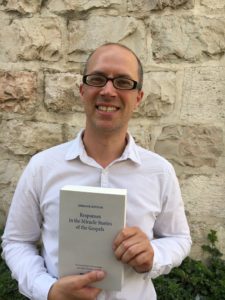
An enormous amount of scholarly attention has been devoted to the miracle stories in the New Testament over the past hundred years, without any sign of the interest abating, as attested by numerous edited volumes published on the topic in the past five years alone.[2] Moreover, beginning already with Martin Dibelius and Rudolf Bultmann, the importance of the frequent descriptions of various individuals’ and groups’ responses as a distinctive part of gospel miracle stories has been acknowledged. Yet, remarkably, prior to the publication of Responses in the Miracle Stories of the Gospels, there had been no focused study of the responses.
In this blog post I will summarize my findings on the questions raised above, which I investigate in the book’s first part, “Towards Artistry.” (The book’s second part, “Towards Tradition,” investigates features of responses shared by the Four Gospels, with implications for the interrelations of the Gospels as well as for the potential influence of oral tradition in the formation of the Jesus tradition. I will discuss the second part in a further blog post.)
I adopt definitions that facilitate an analysis of the literary features in question that is most comprehensive. The group of stories I study is broadly conceived, because by “miracle” I mean not only mighty deeds, such as healings and exorcisms, but also epiphanies, namely appearances of God, angels and also Jesus, when portrayed as more-than-human. (The appropriateness of this approach is in turn affirmed by the analysis of each gospel.) For “response,” I adopt a definition that both is more comprehensive than previous approaches and focuses more on formal aspects, allowing for a determination of a response’s quality based on factors beyond the immediate sentence(s) in question. A response is: a clause (or series of contiguous clauses) that describe one or more characters’ visual perception and/or internalized and/or externalized experience occurring after a miracle. This basic definition covers the vast majority of instances studied, while some flexibility is allowed, whereby certain literary features – notably three lengthy, complex responses in John, involving interaction between characters – can be taken as variations on a familiar theme.
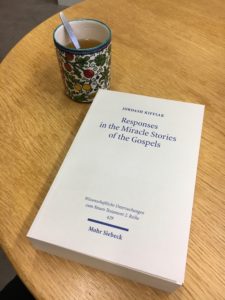
Each of four chapters provides a literary analysis of a particular gospel, on its own terms, to determine the roles that responses play both in the respective miracle stories and in the gospel in question, when taken as a whole. I will summarize my analyses of Mark and John here and comment on a few points from my analyses of Matthew and Luke.
Mark
In the Gospel of Mark, stories of miracles and descriptions of characters responses to them have an important role in the larger, unravelling narrative. Though the various characters’ responses to the miraculous draw on a common body of components – feelings, visual sensation, cognition, verbal utterances, movement to other locations and reporting to others – they function in a variety of capacities. (The fact that responses in epiphanic and non-epiphanic miracle stories draw on a common, limited pool of elements is one factor supporting the more inclusive definition of miracle story.) The diversity of function is relevant to both characterization and plot.
I begin with the former. First, in terms of the respondents, the responses rarely serve to paint a few characters in broad strokes, whether negatively (e.g. the Pharisees) or positively (e.g. Bartimaeus). More commonly they help bring about a complicated picture. For example, amazement at Jesus’ teaching and miracle-working power, exclamations’ singing Jesus’ praise and so forth, naturally have a positive aspect. Yet these responses are often undermined by other aspects of the stories in question, as when an evil spirit’s understanding of Jesus’ identity surpasses that expressed by an amazed crowd in Capernaum. Alternatively, the fame achieved for Jesus through a healed man’s response stems in fact from the respondent’s recalcitrant behavior. The disciples’ fear and verbal exuberance about Jesus’ power is tempered by the narrator’s explicit comment about their ignorance. Characters’ responses to miracles in Mark are presented primarily in terms of the degree of their comprehension and acceptance of the narrator’s understanding of Jesus. The various responses constantly fail to meet the standards set in the narrative’s opening scene, where the divine voice recognizes Jesus as his beloved son.
A second, related point regards how the responses affect the characterization of the miracle worker or the epiphanic character. In part, Jesus is characterized positively on account of the acclamation, amazement, reporting and so forth that respondents engage in. Commonly, however, it is more through the limited understanding of the respondents, that the contours of the figure of Jesus are drawn. Jesus is repeatedly presented as a figure whose identify – known already to the readers and hearers of the text – is superior to other characters’ conceptions of him.
The functional diversity of characters’ responses pertains also to the plot of Mark, greatly informed by miracle stories, which centers on depicting what it means for Jesus to be God’s son.[3] A related, subplot-line pertains to which characters might attain this understanding and when, a set of questions raised in the opening epiphany story, where no character responds to the heavenly voice’s designation of Jesus as God’s son. The unfolding narrative maps out a spectrum of negative to positive estimations of Jesus. Especially the story’s first half, replete with miracle stories, uses the response motif as a significant means for this mapping. All characters fail, some in a manner worse than others.
Miracle stories are sharply divided into two groups of unequal size. A series of four stories – namely, the stilling of the storm, the walking on the water, the transfiguration and the resurrection-related angelophany – are interspersed among the other miracle stories. Here the setting is consistently private and miracles of an epiphanic nature are involved, giving characters a privileged glimpse at the true extent of Jesus’ great power and nature. Established followers of Jesus alone respond, with the response always having an affective element of fear or being troubled. Moreover, each story employs a non-standard focalization (i.e. the narrator is not the [sole] focalizer, but [also] the disciples or Jesus), a form of narration that is rare in this text. These respondents come the closest to understanding who Jesus is, but their comprehension still falls significantly short of the mark.

The second, larger group of miracle stories differs in terms of setting (public or moving from private to public), miracle type (less remarkable miracles, especially healings and exorcisms), respondents (those other than Jesus’ established followers), focalization (consistent narrator-focalizer) and, where present, the affective aspect of the response. For the last point both intensity and kind of feeling is in view. When the response portrays a feeling, amazement is characteristically involved, in contrast to the more intense fear that arises in the epiphanic episodes – the distinction between these affective responses has not been noted in previous scholarship.[4] Typically, respondents in these stories express a limited appreciation of Jesus. At worst, a response is unwelcoming or even hostile and leading towards violence.
The employment of these stories and the respective responses in the course of the developing narrative serves to further the main plot-line and a subplot-line of conflict between Jesus and his disciples. The series of three private, epiphanic miracles for Jesus’ core followers, interspersed among the stories of healings and exorcisms, grow in the level of power displayed and the exclusivity of the setting. The stories build to crescendo, reached at the story’s turning point. In the transfiguration, the narrator uncovers for the gospel’s readers and hearers the powerful, glorious aspect of Jesus’ nature to its fullest extent. But the followers do not comprehend. Their misguided response elicits correction from the heavenly voice, now revealing to them that Jesus is God’s son, recalling the key revelation, made in the opening story. Yet the subsequent description of them merely seeing Jesus, without further response, betrays their lack of understanding, raising the level of tension.
The resolution of the main plot-line is achieved at Jesus’ crucifixion – where the second defining aspect of Jesus’ nature, the suffering servant of all is disclosed – as his execution ironically states that the man crucified is the son of God. Two subplot-lines, however, are held in suspense right up to the narrative’s end (as known from the earliest manuscripts). The relevant questions – “which characters will recognize who Jesus is?” and “will the followers of Jesus be faithful to his call of discipleship?” – are addressed by Mary, Mary and Salome’s fearful response of flight and silence to the angel’s appearance at the tomb. Through the final, unsatisfactory response of Jesus’ established followers in a privileged epiphany, the narrator invites the hearers and readers: to believe that God will eventually accomplish God’s purposes, despite Jesus’ followers’ weaknesses, and also, possibly, to take up the task of telling others about Jesus’ resurrection.
John
Miracles stories in John, which all contain responses, serve the plot in two important ways. They portray the development of belief in Jesus, or lack thereof, through various characters’ encounters with Jesus. Characterization is, thus, very closely related to plot here. The stories also point forward to, alternatively backward to, Jesus’ death and resurrection, infusing these eschatological events with meaning.[5] Responses play a notable role in both regards. As for characterization, when responses depict faith, it is typically a level of belief that has grown as the events in question progress. It should be noted that the sign stories – eleven in my reading – include not just the initial seven stories occurring in the first half of the narrative, but also the four post-resurrection episodes in which Jesus appears to one or more disciples.
Beginning with Jesus’ initial call of a few disciples, the narrative develops as Jesus encounters various individuals and groups, who display a variety of levels of belief in him. In their response to the opening sign, the turning of water to wine, the already burgeoning faith of the first followers, begun in their conversations with Jesus, grows further. Though belief language is explicitly used in the responses both here and in the following sign story, both of which are articulated briefly, later responses will typically depict the presence or absence of belief by other means. In the first miracle story, the disciples’ belief in Jesus is connected to the imminent hour in which he will be glorified, anticipating the eschatological events of Jesus’ death and resurrection and resultant benefits that will then inspire a yet superior faith.
Following a conversation with the socially privileged Jewish Nicodemus, which fails to inspire faith, and another one with the socially disadvantaged Samaritan woman, which succeeds, Jesus’ second sign, a healing, brings the extant faith of a royal official in the Galilee to a greater depth. In the third sign story, a watershed episode, sees the first negative use of the response motif. Following the healing of the incapacitated man at the pool of Bethesda, the recipient’s ambiguous response serves to endanger Jesus, exposing him to his opponents. Their response, seeking to kill Jesus, is more blatantly unsatisfactory. The response motif is here stretched substantially beyond its typical formal composition, as the actions of these two respondents, an individual and a group, are developed through a series of interactions between not only them, but also them and Jesus. That the story ends with what is effectively a monologue by Jesus, as did the episode with Nicodemus, seals the picture of failure to believe.
Even seemingly positive responses can express something other than adequate belief. The crowd’s proclamation that Jesus is a great prophet following a spectacular provision of food is thoroughly undermined, both by Jesus’ uncanny awareness of their inappropriate assessment of him and wrong intentions and by later dialogue which exposes these shortcomings. When Jesus, walking on the water, reveals himself by saying “I am,” the disciples fail to grasp the significance of what is being done and said. (Though Jesus’ speech is for the present ambiguous, the phrase “I am,” which first appears here, will later be invested with meaning.) The disciples’ fearful response upon seeing this epiphany of Jesus is followed by a lack of appreciation of Jesus’ self-revelation. The absence of a response at the episode’s end indicates that their faith has not developed in response to the miraculous happening as it ought to have.
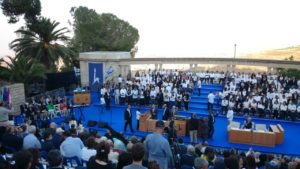
The healing from blindness, like the earlier healing at Bethesda, is followed by a complex response, involving the actions of numerous characters, interacting with one another and with Jesus. The healed man’s development in faith is brought to a peak, with a literary feature that recalls the shorter responses from earlier episodes, when he expresses a well-developed belief in Jesus, indicated through his prostration and verbal confession of faith. Various points connecting the story here to the last episode of healing, further demonstrate the inferiority of the incapacitated man’s response there. The other main respondents here, the religious authorities, again respond with hostility. An extended speech from Jesus again occupies the latter part of the story. Freedom from physical blindness pertains also to a soon-coming eschatological gift, by which characters and the hearers and readers of John will be able to recognize Jesus for who he truly is.
In a twist of convention, Martha articulates, prior to the resurrection of Lazarus, a pronounced expression of faith in Jesus. The resurrection itself leads to some Judeans believing in him, though others report on him to the Pharisees. As in chapters five and nine, a lengthy response involves multiple characters and interactions. It culminates in a decision by the religious authorities to kill Jesus. Thus, the initial seven sign stories come to a close, pointing forward to the imminent eschatological moment of Jesus’ passion and resurrection.
Subsequent to Jesus’ resurrection a series of three encounters between his followers and him occurs. Like the similar series of encounters at the narrative’s opening, the occurrences here build on each other. Martha reports to the other disciples that she has seen “the Lord,” just as they then in turn provide Thomas with a similar, faith-filled report. The culminating moment, when one previously skeptical becomes the mouthpiece of the greatest statement about Jesus in the Fourth Gospel, Thomas proclaims Jesus to be his Lord and his God, while seeing the crucified and risen one. (In the narrative’s dénouement, where Jesus interacts with his disciples in the Galilee, the response motif plays just a secondary role.)
Matthew and Luke
I can give here only a brief sampling from the results of the analyses of Matthew and Luke. One point of interest is in Matthew’s opening sequence of appearances of the Angel of the Lord, where Joseph’s responses, repeatedly exhibiting verbal parallelism with the angelic commands, underscore that God’s plan will be accomplished despite human and diabolical resistance and machinations. Given the primacy effect, one can expect a victory from God in the overall plot, despite whatever complications will arise. Alternatively, the inadequacy of a response can catch the readers and hearers of the Gospel by surprise. Thus, the disciples’ prostration in the boat before Jesus and proclamation “You are truly the son of God” is later revealed as inadequate. Since later, at Jesus’ transfiguration, a voice from heaven has to articulate this same message to an exclusive group of disciples, despite their being privy to an extraordinary revelation of Jesus, the shallowness of the understanding laying behind the disciples’ earlier proclamation is exposed.
In Luke, responses involving praise are best appreciated when understood within the larger, unfolding narrative. They are more complex than has usually been observed. The Pharisees’ praise-filled response to the paralytic’s healing and later a crowd’s more impassioned praise and commendation of Jesus are undermined, respectively, by the Pharisees antagonistic response to a later healing and Jesus’ chastisement of Galilean towns in this generation who have not responded with repentance at the mighty deeds he has performed. Towards the climax of the narrative, the series of post-resurrection appearances – first of an angel, then of Jesus – help to peel away the layers of the disciples’ misunderstanding und unbelief about the necessity of Jesus’ suffering and death to fulfil God’s plan. The responses in these miracle stories serve to depict an important part of this process of enlightenment.

Interestingly, both Matthew and Luke contain versions of a miracle story in which the response motif is creatively inverted. Jesus’ reaction to the Capernaum centurion’s expression of faith – prior to the accomplishment of the healing – involves amazement and speech, very much like the amazed, verbal responses to miracles occurring in other stories. The twist in use of the convention serves to further underscore the remarkable faith in Jesus exhibited by this Gentile petitioner.
What’s coming up next time?
In the next blog post, I will summarize the book’s lengthy analysis of responses as they shed light on the interrelations of the Gospels – the Synoptic Problem in particular, but also all four of the Gospels taken together – including the role oral tradition may play. I will then relate the findings of the book’s concluding, preliminary analysis of the traditional influences on the gospel miracle stories, paying special attention to the differences between ancient Jewish and non-Jewish stories about the miraculous.

Jordash Kiffiak is working on a postdoctoral project (Forschungskredit) at the University of Zurich with Prof. Jörg Frey, investigating whether Jewish or non-Jewish miracle stories provide a better context for understanding the response motif found in the Gospels (Responses to Miracles in Jewish and Non-Jewish Narratives). Since 2007 he has taught ancient languages – biblical Hebrew, Syriac and, especially, Hellenistic Greek – using innovative, communicative approaches at various institutes, including the University of Zurich.
Footnotes
[1] The book, a revised and enlarged version of my doctoral dissertation, supervised by Serge Ruzer and Loren Stuckenbruck and accepted by the Hebrew University in July 2015, was printed as volume 429 in Mohr Siebeck’s WUNT II series earlier this year.
[2] D. F. Watson, ed., Miracle Discourse in the New Testament (Atlanta, Ga.: SBL, 2012); S. Alkier and A. Weissenrieder, eds., Miracles Revisited: New Testament Miracle Stories and Their Concepts of Reality, SBR, 2 (Berlin: De Gruyter, 2013); T. Nicklas and J. E. Spittler, eds., Credible, Incredible: The Miraculous in the Ancient Mediterranean, WUNT I, 321 (Tübingen: Mohr Siebeck, 2013); R. Zimmermann (ed.), Kompendium der frühchristlichen Wundererzählungen, Band 1: Die Wunder Jesu, in collaboration with D. Dormeyer, J. Hartenstein, C. Münch, E. E. Popkes and U. Poplutz (Gütersloh: Gütersloher Verlagshaus, 2013); B. Kollmann and R. Zimmermann, eds., Hermeneutik der frühchristlichen Wundererzählungen: Geschichtliche, literarische und rezeptionsorientierte Perspektiven, WUNT I, 339 (Tübingen: Mohr Siebeck, 2014).
[3] My conception of the plot of Mark adopts, along broad lines, that articulated by R. Alan Culpepper, Mark, SHBS, 20 (Macon, Ga.: Smyth and Helwys, 2007), 18–19, 49.
[4] The difference in affective responses in the two groups of stories is particularly noteworthy, as feelings are the most characteristic component of responses in Mark, both quantitatively and qualitatively (in terms of prominence in the discourse). For further discussion of the semantic distinction in Greek between terminology referring to fear and amazement, see my essay “Amazement, Fear and Being Troubled in Responses in Gospel Miracle Stories: Establishing the Semantic Contours of the Terms and Their Interrelations” in From Ancient Manuscripts to Modern Dictionaries: Select Studies in Aramaic, Hebrew, and Greek, Perspectives on Linguistics and Ancient Languages (eds. Tarsee Li and Keith Dyer; Piscataway, New Jersey: Gorgias, 2017).
[5] My conception of the plot of John relies on the work of R. Alan Culpepper, Anatomy of the Fourth Gospel: A Study in Literary Design, Foundations and Facets (Philadelphia: Fortress, 1983), with important modifications based on insights from Francis J. Moloney, The Gospel of John, SP, 4 (Collegeville, Minn.: Liturgical, 1998) and Jörg Frey, Die Herrlichkeit des Gekreuzigten: Studien zu den johanneischen Schriften 1, ed. Juliane Schlegel, WUNT I, 307 (Tübingen: Mohr Siebeck, 2013).
Abgelegt unter: From us or people associated with us⋅ New Publications⋅ People
5. April 2017 |
Christoph Heilig |
1 Kommentar
Our volume God and the Faithfulness of Paul (edited by Christoph Heilig, J. Thomas Hewitt, and Michael F. Bird) has now been published by Fortress Press and is available on Amazon.com (for Germany see here, for the UK here). There you can also get an extensive preview through the “Look Inside”-function. Note, that there is also a kindle edition for a fantastic price!
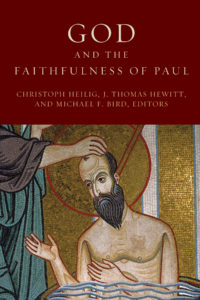
This means that our detailed examination of N. T. Wright’s Paul and the Faithfulness of God is now available in several editions, which can serve different needs:
- If premium-quality material is important to you, the Mohr Siebeck edition is probably the first choice for you.
- The Fortress edition, on the other hand, makes this volume accessible by offering it for a really low price. We are very grateful to the publisher for this and I believe that one could not ask for a better deal for getting a collection of essays by 30 international experts on the issues discussed in this publication!
- Note, that the book is now also available on Logos for this low price. This might be of particular interest for you if you engage Wright’s work regularly and the search-options are of importance for you. An especially noteworthy feature of the Logos edition is that references to Wright’s PFG are hyperlinked!
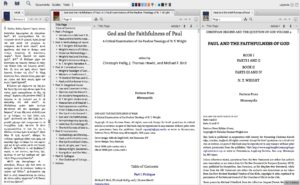
If you would like to learn more about the project, you can find summaries of the essays that were contributed by our department on this blog (see here, here, and here).
Here are two endorsements provided by Fortress:
The interaction with Wright in this volume testifies to his fascinating and fecund scholarship. Scholars with different areas of expertise and from a diversity of perspectives concur with, challenge, and broaden what Wright has written. Good conversations invariably deepen our own understanding, and we can be grateful that this volume represents dialogue at its best. — Thomas R. Schreiner, Southern Baptist Theological Seminary
I am delighted that my work on Paul has generated such warm interest and substantial engagement, which has also given me the chance to take some of the conversations to the next stage. Even where I profoundly disagree with some of the things that are said, I am very grateful to authors and editors for keeping the discussion going in so many important directions. — N. T. Wright, Research Professor of New Testament and Early Christianity, University of St. Andrews
If you are still unsure as to whether you should buy the book, the following excerpts from reviews might help you to reach a decision:
In the area of Pauline theology, this is nearly a must-have. … This new work from Mohr Siebeck, with its thorough and extensive interaction with the new Pauline blockbuster, is a most important book to own. … I highly recommend it to any students of Pauline theology and even to pastors who want to engage in rigorous Pauline debates. For Pauline scholars, it would be irresponsible not to own this volume! — Todd Scacewater, Exegetical Tools
One of the 10 best books in Biblical Studies for 2016 — Andreas Köstenberger, Biblical Foundations™
This volume is an extraordinary achievement … [It] is utterly stimulating and thoroughly engaging. — Jim West
First, … God and the Faithfulness of Paul should be required reading for anyone engaged in Pauline scholarship or seeking to write a dissertation in Pauline studies. The scope of the volume is so broad that it touches almost every major area in the field. The book is worth reading cover to cover for those in this category. It is also an important work for any biblical scholar to have in his library for reference.
Second, the book will also prove helpful for pastors and educatedlaypeople who want to stay abreast with cutting-edge Paulinescholarship. … Receiving the fruit ofscholarship from key experts in the field is well worth the effort of aclose reading of these chapters.
Finally, anyone wanting to work through PFG in a thoughtful manner will want to have God and the Faithfulness of Paul within arm’s reach as a guide for understanding Wright’s magnum opus.
[GFP] will be an invaluable resource for engaging with Wright for years to come. — Mark Baker, Books at a Glance
Abgelegt unter: From us or people associated with us
23. February 2017 |
Christoph Heilig |
2 Kommentare
Introduction
Reflecting upon the different events we had staged during 2016, the fact attracted my attention that we had had three workshops on various aspects of ancient languages and that they – even though they dealt with quite different issues and even though I would not want to claim that it is possible to identify a “core” of convictions the presenters shared – mutually re-emphasized each other. We began with a workshop by Heinrich von Siebenthal on his approach to analyzing Greek texts from a linguistic point of view. I contributed a workshop on lexical semantics and the importance of the Online TLG corpus in determining both semantic range and discourse meaning of Greek words. Towards the end of the year, Jordash Kiffiak introduced us to a modern approach to learning ancient languages that is increasingly gaining a following. The last mentioned topic deserves a blog post on its own and I have already written about my thoughts on “word studies” elsewhere on this blog. Hence, I will focus here on the event with Heinrich von Siebenthal. Nevertheless, I think it might be interesting for our readers to point out some connecting elements between his approach and the other two events on ancient languages that took place last year.

Heinrich von Siebenthal on “Lexical-Grammatical and Semantic-Communicative Analysis”
If you know anything about the German tradition of Greek grammars, it is probably because you have worked with “Blass-Debrunner-Funk” in the past. This is the English revision of a project that had originally been published in 1896 (!).In many ways, of course, this work remains an excellent Greek grammar. Nevertheless, in other respects both BDF and its German counterpart (“Blass-Debrunner-Rehkoph”) can no longer be trusted. But while there are by now multiple alternatives in the English-speaking sphere, BDR still remains quite influential among German-speaking exegetes. This is quite unfortunate, since the whole section on the verbal system is untenably outdated. Even if one broadens the view beyond grammars that deal specifically with the New Testament, the situation is astonishingly sparse: The standard school grammar by Bornemann-Risch dates to 1978 (and is also quite problematic with regard to the verbal system) and the most detailed scholarly grammar by Kühner-Blass-Gerth is (even in the latest revision by Gerth, which has, by the way, just been reprinted by the WBG in 2015!) more than 100 years old …
Against this background, the significance of Heinrich von Siebenthal’s grammar on the Greek of the New Testament (Griechische Grammatik zum Neuen Testament [Gießen: Brunnen/Immanuel, 2011) – a heavily reworked version of his earlier publication together with Hoffmann (1985 and revised in 1990) – should be apparent. His grammar is also available in Logos and I believe there are plans for a translation.
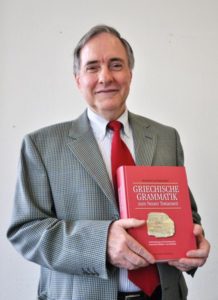
Just recently, von Siebenthal has made a similarly pioneering contribution to Hebrew grammar through his Grammatik des Biblischen Hebräisch (building on the work of Jan P. Lettinga), finally offering an alternative to the grammar by Wilhelm Gesenius – which to this day is reprinted in the form of the 28th edition (revised by Emil Kautzsch) from 1909 (with the English translation by Ernest Cowley having been published in 1910)!
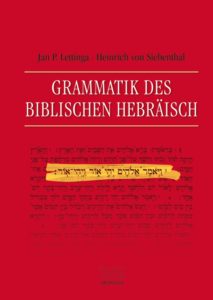
It was a great honor for us that we were able to begin our activities with a workshop by von Siebenthal on the method that he has taught for decades for analyzing the text of the New Testament.
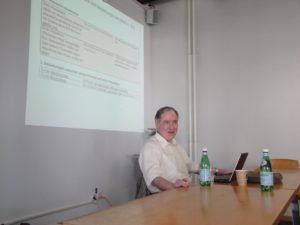
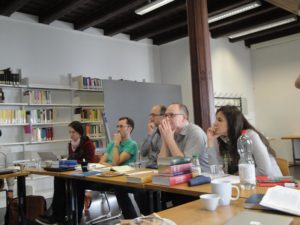
This approach can even be recognized by taking a look at the grammar itself: What is notable is not simply the fact that it incorporates more recent research on hotly debated issues such as the verbal system (on this topic, see this post by Wayne Coppins), but also the fact that it ends with a long section on “text grammar” (§297–§354). Thus, von Siebenthal is obviously not only concerned with offering tools for deciphering syntactical structures on the level of clauses and sentences but also with texts – how they are structured and how they are to be understood!
While the grammar offers a summary of the categories that are relevant in that regard, von Siebenthal has described the analytical steps that are necessary to that end elsewhere in more detail, namely in his essay “Linguistische Methodenschritte: Textanalyse und Übersetzung” (Pages 51–100 in Das Studium des Neuen Testaments: Einführung in die Methoden der Exegese. Revised Edition. Edited by Heinz-Werner Neudorfer and Eckhard J. Schnabel. Wuppertal: Brunnen, 2006). The foundations of this approach from the perspective of general linguistics are, unfortunately, only available in the chapter “Sprachwissenschaftliche Aspekte,” which had been published in an earlier version of that text book (Pages 69–154 in Das Studium des Neuen Testaments. Vol. 1: Eine Einführung in die Methoden der Exegese. Edited by Heinz-Werner Neudorfer and Eckhard J. Schnabel. Wuppertal: Brunnen, 2000). In most general terms, von Siebenthal’s approach centers around the conviction that for exegetes it is important to take into account both the “expression” side and the “content” side of textual structure.
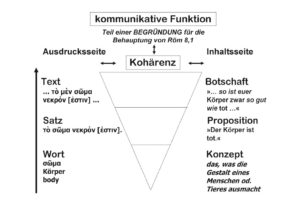
The first step – the lexical-grammatical analysis – aims at making the syntactical structure of a passage visible (the example is James 1:2–4).
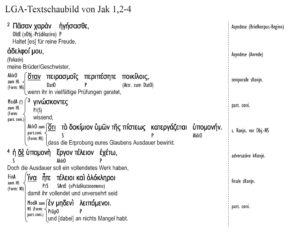
As you can see, each clause and also each textual feature that has an equivalent function (“satzwertige Konstruktionen,” i.e. participles, etc.) gets assigned to a new line and is indented if it is grammatically subordinate.
In a next step – the semantic-communicative analysis – von Siebenthal wants us to focus on the corresponding propositions and how they form a semantic structure. The individual elements of the lexical-grammatical analysis form the point of departure for this step. Even action nouns and prepositional phrases that function attributively can function as the point of departure for a proposition. However, what we are now putting in relation to each other are not the Greek expressions themselves but rather elements of meaning (which we express by using the sign system of our modern languages due to the fact that we lack competencies to do so in the original language). So while the semantic-communicative analysis remains related to the level of expression, a different set of features is focused on here. As a result of this step, we might get a hierarchical structure of the semantic relations within a passage that looks like this:
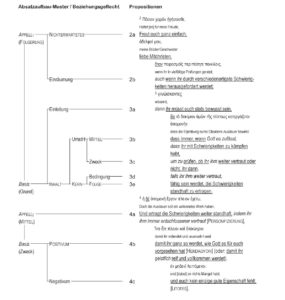
There are several reasons for why I think that every exegete should work on his or her text at least once from this perspective:
-
Often, we read exegetical arguments that do not in fact incorporate all the elements of the text. There is a focus on a specific word or cross-connection but it is not demonstrated how the passage as a whole is structured in a way that the interpretation of this individual element fits in.
-
What is true on the level of lexical semantics is all the more true on the level of textual semantics: In order to support their theses, biblical scholars quite frequently oscillate between the level of expression and the level of content, without signaling this sufficiently. If one wants to make any argument about the meaning of a text, it is however necessary, a) to explain how the postulated semantic network arises on the foundation of the linguistic actualities and b) how this network itself is structured.
-
The method is very practical in that it combines semantics and pragmatics. In other words, the “thing” we want to determine in the semantic-communicative analysis is what the author wanted to communicate to his audience. Therefore, a lot is to be included in this diagram that needs to be supplied from our analysis of the historical background, literary context, etc. Although it should go without saying, it might perhaps be worth stressing that von Siebenthal’s approach does not offer a linguistic-bulletproof method for introducing these elements, which must, of course, be collected within the methodologically appropriate tools. However, where von Siebenthal’s framework is really helpful is in making visible the precise points at which we supply such information and how this information changes the overall content. Sometimes when I read long sections in a commentary on a specific biblical passage that is difficult to understand, I wonder whether the author would have been able to supply me with such a semantic-communicative analysis. For the paraphrase that results in this step is, after all, nothing but the densest formulation of a commentary in the best sense, i.e. an explication of what the text in question is meant to express. My guess would be that all too often commentators would not be able to bring their exegesis into such a form – which would raise the question of whether the much longer – but with regard to content rather poor – explanations are worth the paper they are published on.
-
This leads me to the final advantage of von Siebenthal’s approach as I see it. There is not only a heuristic gain inherent in it. It also helps us to better communicate about our exegesis by offering structures and categories. Often, when we discuss research papers, we simply point to a particular aspect we did not really like for some reason or for which we happened to know some facts by coincidence. However, it is at least not unusual that it is unclear how our contribution affects the actual argument of the presenter. Having a clear structure of the text – both of the level of expression and the level of content – before us, we can, by contrast, easily identify crucial issues and how they relate to the overall interpretation, e.g., by discussing how γινώσκοντες in James 1:3 should be understood and how this influences our reconstruction of the “Kommunikat” (that which is communicated).
If you are interested in performing such an analysis yourself, you can use this free software (link), which is really helpful for connecting propositions. If you are looking for an English-speaking introduction I suggest you familiarize yourself with the work of the “Summer Institute of Linguistics” and with, what they call, “Semantic Structure Analysis” (link), which had served as point of departure for von Siebenthal’s own methodological sketch.
There are, of course, some limitations to this approach but this does not, in my opinion, diminish the necessity to do something along these lines in the process of trying to understand what an ancient author attempted to communicate. What is noteworthy is the fact that von Siebenthal is quite traditional with regard to the nature of connectors. One might want to compare his holding on to different meanings of connectors such as δέ with the discourse grammar by Steven E. Runge. Still, I would like to advocate that this by no means implies that von Siebenthal’s assumes an outdated notion of ‘text,’ in which a text is nothing more than a collection of sentences and is to be analyzed by the same set of tools as the smaller units. Quite the contrary is the case! Von Siebenthal explicitly builds on the textual notion of Christina Gansel and Frank Jürgens (Textlinguistik und Textgrammatik, Göttingen: Vandenhoeck & Ruprecht), who advocate an “integrative text model,” which incorporates communicative (and, thus, social) functions. So, if there is a danger with regard to misusing von Siebenthal’s methodological approach, I would argue that it resides in an outdated of the concept of “text” on the side of potential users.
On Learning and Understanding Languages
This last consideration leads me to a workshop that we have had only very recently. Jordash Kiffiak is one of the very few people worldwide who teach Koine Greek, Biblical Hebrew, and Classical Syriac as spoken languages. He learnt to speak Hellenistic Greek from both Randall Buth (Biblical Language Center) and Christoph Rico (Polis – The Jerusalem Institute of Languages and Humanities) during his time living in Jerusalem and the communicative approach he uses makes use of modern pedagogical insights, such as James J. Ashers “Total Physical Response” method and Ray Blaine’s and Contee Seely’s emphasis on storytelling in achieving fluency. Kiffiak’s use of a communicative approach is especially indebted to his time teaching for the Biblical Language Center and to mentoring by Randall Buth in particular. He is the co-author of a new beginner’s textbook for Christian Aramaic (i.e. Syriac) that is to be published in 2017.
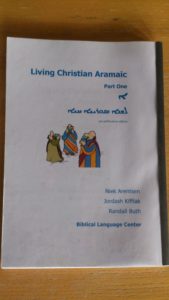
Kiffiak will himself introduce in due course on this blog the method he uses. What I would like to do here is to draw some connecting lines – as they appear to me – to what von Siebenthal has taught us.
In this particular workshop, Jordash Kiffiak first gave us a general introduction into the foundations of this method of learning ancient languages and then demonstrated his points by making us learn quite a bit of the basics in Syriac in only two hours – and in a very playful and low-stress way. At the end of the workshop he gave a brief demonstration, immersed now in Hellenistic Greek, of how intermediate students can be lead through a discussion of an unadapted ancient text, using comprehensive questions in the target language.


Now, at first sight this whole event might seem to stand in a rather stark contrast to von Siebenthal’s quite theoretical analyses. However, the more I think about it the more the two approaches seem to go hand in hand. After all, Kiffiak’s work aims at learners internalizing as much of the core vocabulary, forms and structures in a given language as possible. The approach, therefore, is not simply about learning a language without having to experience the headache of memorization using flashcards. In other words, it would certainly be wrong to think that such an approach is perhaps suitable for students who are not very serious about ancient languages but not so much for people enrolled in a biblical studies program. Quite the contrary is the case. While most students who learn languages such as Ancient Greek through traditional methods never achieve fluency and are often not even able to read a simple piece of text from the New Testament without the assistance of software, Kiffiak’s approach specifically aims at preparing people for being able to read and understand texts written in Koine Greek without such tools.
Also, it became clear to me as I continued to reflect upon my experience during this wrkshop that Kiffiak’s work is not just about different didactic strategies. It has also very significant implications for how we as exegetes approach the texts we are working on. And in that regard I suddenly realized that von Siebenthal’s and Jordash Kiffiak’s contribution to our attitude towards ancient languages such as Koine Greek is actually quite similar. For the majority of features unique to von Siebenthal’s grammar are, after all, associated with his linguistic indebtedness to text linguistics and are, thus, much more concerned with the actual regularities of texts than this is the case in every other Greek grammar I know. Just compare what Gansel and Jürgens (3rd ed.; 2009, p. 175) say about their compilation of “text-grammatical structures” of the German language. They are aiming at:
“… eine realistische Grammatik des Deutschen in geschrieben und gesprochenen realisierten Textsorten vorzulegen, eine Grammatik, die den realen Sprecher/Hörer und Schreiber/Leser in den Mittelpunkt stellt und die Regelhaftigkeiten des Sprachgebrauchs in Texten/Textsorten herausarbeitet. Strukturelle Gegebenheiten der natürlichen gesprochenen Sprache sind also ausdrücklich ein expliziter Bestandteil einer solchen Grammatik.”
(My translation:)
“… to produce a realistic grammar of German as it appears in text sorts of both written and spoken realization – a grammar, which places the real speaker/hearer and writer/reader into the focus and works out the regularities of linguistic usage in text/text sorts. Structural actualities of the natural spoken language are, thus, emphatically an explicit part of such a grammar.”
Analogously, von Siebenthal’s Greek text grammar includes features such as “Mitzuverstehendes” (e.g., semantic and logical presuppositions; §314). Furthermore, it is noteworthy that although von Siebenthal’s text book on Koine Greek (Grundkurs Neutestamentliches Griechisch [Giessen: Brunnen, 2008]) is methodologically quite different from Jordash Kiffiak’s approach at first sight – in that it encourages to explicitly memorize many rules of how to translate Greek clauses – even here it still shares some common ground. Von Siebenthal’s book builds on a method developed by Otto Wittstock that makes use of insights from simultaneous translating of modern languages. Students are meant to learn reading Greek texts in a way that is similar to how professional interpreters work. While translation is not a key component of Kiffiak’s approach, the simultaneous translation of modern languages has in common with Kiffiak’s communicative approach to learning ancient language an emphasis on processing communication at the rate of speech.
Why is all this relevant for our actual exegetical work? Well, I would like to argue that how we study a specific text is necessarily influenced by what we explicitly and implicitly hold to be true about the language it is written in. What I have become increasingly aware of is the fact that these presuppositions are also shaped by how we have learnt that language. As Michael Jost, researcher at the University of Bern and member of our Peer Mentoring Group, put it after the workshop: “We tend to treat these dead languages as if they had always been dead!”
There are two areas that come to my mind specifically in which both the emphases of von Siebenthal as well as the pedagogical approach of Kiffiak might help avoiding exegetical fallacies by giving us a more realistic notion of what these ancient languages actually are.
- First, while exegetes usually do not justify their exegetical moves through analyses as taught by von Siebenthal, on the one hand, they sometimes point to very specific textual phenomena and refer to what they think are strict grammatical rules, on the other hand, to make a point about a tiny detail of the text – which then in turn influences how the whole passage is interpreted. Knowing a bit of modern Greek, I cannot but wonder whether this way of doing things does not often mistreat the texts as raw material for speculations mostly fed by our lack of familiarity with the language itself. Interestingly, aiming for over-precision (and justifying it by referring to grammatical categories no native speaker would have been able to understand, such as a separate genitive for almost every noun) was the number-one-concern of von Siebenthal, when we asked him at the workshop what kind of problems he most often sees in exegetical literature from his linguistic perspective.
- Second, in the area of lexical semantics von Siebenthal’s and Kiffiak’s different approaches have a similar significance in relation to a consideration that is quite important in my mind. I do not want to go into the details of my own workshop on lexical semantics and the TLG corpus here because it basically was a summary of my research that has recently been published by Peeters and for which I have written a separate blog post.
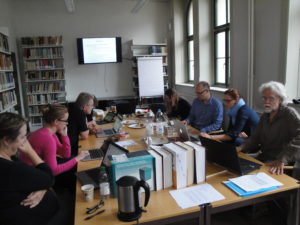 However, what I would like to point out here is that I have personally profited a lot from von Siebenthal’s semantic-communicative emphasis with regard to determining the discourse meaning of a specific word in a given NT passage. Similarly, I think that it can be shown on the basis of considerations from the field of the philosophy of science (see for this the essay I co-authored with Theresa Heilig) that in order to determine how a word is used in a NT passage, it is of immense significance to be familiar with what the paradigmatic options would be – i.e. familiarity with other words that could have been used in that place of the syntactical structure. In other words (offering a short summary of what I wrote in the other post on word studies), what happens quite often is that students (and sometimes also more senior scholars) of the NT make decisions concerning the semantics of an expression in the passage under consideration on the basis of that word being most often used with a certain meaning. What they too often ignore entirely, however, is whether it might be the case that this ratio of meanings for that lexeme is simply due to the fact that this semantic content is expressed quite rarely in general. If that were the case, the fact that a meaning occurs towards the end of our dictionary entry is almost completely irrelevant for deciding whether this is the meaning we should assume in a specific passage. It could still be the most probable meaning for that text! What we need to focus on instead is the question of whether there would have been more likely lexical solutions for this semantic-communicative problem (and what kind of “content” the context makes us expect regardless of the actual lexical choice). That is to say, we have to know what lexical alternatives a native speaker would have had to express the same concept. This is, of course, a question no dictionary can answer for us and a competency students usually do not develop at all – for it requires a familiarity with the language that goes beyond translation equivalents, i.e., a Sprachgefühl as students could develop if they learnt their ancient languages along the lines of the method Jordash Kiffiak uses in his teaching.
However, what I would like to point out here is that I have personally profited a lot from von Siebenthal’s semantic-communicative emphasis with regard to determining the discourse meaning of a specific word in a given NT passage. Similarly, I think that it can be shown on the basis of considerations from the field of the philosophy of science (see for this the essay I co-authored with Theresa Heilig) that in order to determine how a word is used in a NT passage, it is of immense significance to be familiar with what the paradigmatic options would be – i.e. familiarity with other words that could have been used in that place of the syntactical structure. In other words (offering a short summary of what I wrote in the other post on word studies), what happens quite often is that students (and sometimes also more senior scholars) of the NT make decisions concerning the semantics of an expression in the passage under consideration on the basis of that word being most often used with a certain meaning. What they too often ignore entirely, however, is whether it might be the case that this ratio of meanings for that lexeme is simply due to the fact that this semantic content is expressed quite rarely in general. If that were the case, the fact that a meaning occurs towards the end of our dictionary entry is almost completely irrelevant for deciding whether this is the meaning we should assume in a specific passage. It could still be the most probable meaning for that text! What we need to focus on instead is the question of whether there would have been more likely lexical solutions for this semantic-communicative problem (and what kind of “content” the context makes us expect regardless of the actual lexical choice). That is to say, we have to know what lexical alternatives a native speaker would have had to express the same concept. This is, of course, a question no dictionary can answer for us and a competency students usually do not develop at all – for it requires a familiarity with the language that goes beyond translation equivalents, i.e., a Sprachgefühl as students could develop if they learnt their ancient languages along the lines of the method Jordash Kiffiak uses in his teaching.
Christoph Heilig is working on an SNF-Project on “Narrative-Substructures in the Letters of Paul” with Prof. Jörg Frey. He is the author of Hidden Criticism? Methodology and Plausibility of the Search for a Counter-Imperial Subtext in Paul, (Mohr Siebeck, 2015) and Paul’s Triumph: Reassessing 2 Corinthians 2:14 in Its Literary and Historical Context, (Peeters, 2017). Additionally, he has co-translated (with Wayne Coppins, the main translator and editor of the project) Michael Wolters The Gospel According to Luke and co-edited (with J. Thomas Hewitt and Michael F. Bird) God and the Faithfulness of Paul: A Critical Examination of the Pauline Theology of N. T. Wright (Mohr Siebeck, 2016).
Abgelegt unter: People⋅ Reports

































































